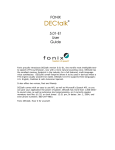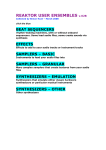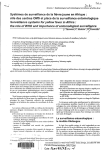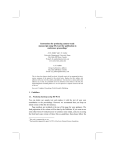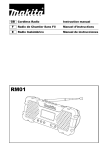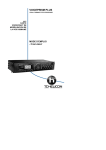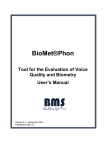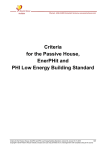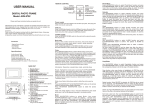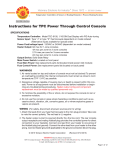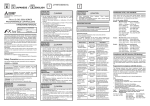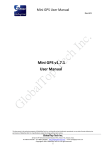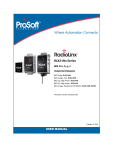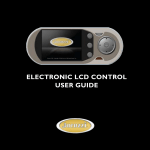Download DECtalk 5.01-E1 User Guide
Transcript
Fonix proudly introduces DECtalk version 5.01-E1, the world’s most intelligible text-tospeech (TTS) synthesizer, now with a more natural sounding voice. DECtalk has the
smallest memory footprint in the industry for a full featured, multi-language voice
synthesizer. DECtalk’s small footprint allows it to be used in devices where a TTS engine
usually wouldn't be viable. DECtalk 5.01-E1 supports three languages: U.S. English,
Castilian & Latin American Spanish.
It also offers two voices, Paul and Wendy.
DECtalk comes with an easy to use API, as well as Microsoft's Speech API, so you can give
your application the power of speech. DECtalk has more than 1,400 letter-to-sound rules,
as well as extensive text preprocessing, so it correctly speaks monetary text like: $1.25, or
clock times: 12:31 pm, or dates: Jan. 1, 2004, and even phone numbers: 800-297-4863.
Fonix DECtalk. Hear it for yourself.
Table Of Contents
Fonix DECtalk software ............................................................................................. 1
Welcome to DECtalk .............................................................................................. 1
Conventions ......................................................................................................... 2
Copyrights and trademarks ..................................................................................... 4
Licensing ............................................................................................................. 6
In-line commands .................................................................................................... 7
Comma Pause [:comma] ........................................................................................ 7
Design voice [:dv] ................................................................................................. 8
Mode [:mode] ...................................................................................................... 9
Name [:name] .................................................................................................... 11
Period Pause [:period] ......................................................................................... 13
Phoneme Interpretation [:phoneme] ...................................................................... 14
Pitch [:pitch] ...................................................................................................... 16
Pronounce [:pronounce] ....................................................................................... 17
Punctuation [:punct]............................................................................................ 18
Rate Selection [:rate] .......................................................................................... 19
Say [:say] .......................................................................................................... 20
Skip [:skip] ........................................................................................................ 21
Using in-line commands .......................................................................................... 22
Introduction ....................................................................................................... 22
Rules and syntax................................................................................................. 23
Optimizing spoken text ........................................................................................ 25
Period and comma pause durations ........................................................................ 27
Text-tuning example............................................................................................ 28
Electronic mail-reading example ............................................................................ 30
Avoiding common errors ...................................................................................... 32
Customizing DECtalk voices ..................................................................................... 33
Introduction ....................................................................................................... 33
ii
Table Of Contents
Voice Definitions .............................................................................................. 34
Changing Gender and Head Size......................................................................... 36
Changing Voice Quality ..................................................................................... 38
Changing Pitch and Intonation ........................................................................... 40
Reference tables .................................................................................................... 43
Index ................................................................................................................ 43
Phonetic symbols - US English .............................................................................. 44
Phonetic symbols - Castilian Spanish ...................................................................... 47
Phonetic symbols - Latin American Spanish ............................................................. 49
Stress and syntactic symbols ................................................................................ 51
English phonemes in unicode sequence .................................................................. 52
Pitch and duration of tones ................................................................................... 56
Tone table .......................................................................................................... 57
Homographs ....................................................................................................... 59
Homograph phonetics: A ...................................................................................... 60
Homograph phonetics: B-C ................................................................................... 61
Homograph phonetics: D-H .................................................................................. 62
Homograph phonetics: I-L .................................................................................... 64
Homograph phonetics: M-P ................................................................................... 65
Homograph phonetics: R ...................................................................................... 67
Homograph phonetics: S-W .................................................................................. 68
Preprocessor parsing rules ...................................................................................... 69
Introduction ....................................................................................................... 69
Punctuation parsing rules ..................................................................................... 70
General parsing rules ........................................................................................... 72
Abbreviations ........................................................................................................ 74
US English abbreviations ...................................................................................... 74
Software examples ................................................................................................. 80
Index ................................................................................................................... 83
iii
Fonix DECtalk software
Welcome to DECtalk
DECtalk converts ASCII text into speech without special or proprietary hardware. The most
important features of DECtalk text-to-speech (TTS) technology are described below.
High-Quality Speech
Represents the latest in speech synthesis technology.
Requires only a standard sound card for audio output.
Provides three different voices.
Programmatically controls voice pitch, rate of speech, and word/phrase emphasis.
Word Pronunciation Accuracy
Accurately reads ASCII text from a variety of sources, including electronic mail and
word processors.
Letter, Word, and Clause Modes
Provides normal clause buffering for natural speech.
Speaks letters, words, phrases, clauses, paragraphs, and even whole documents.
Speaks single characters immediately (doesn't have to buffer an entire clause).
Can terminate speech immediately (buffered text doesn't have to complete
processing).
Pronunciation Heuristics
Recognizes and pronounces non-word sequences, including sequences with
uppercase initials (e.g., FBI and AAA) and sequences without vowels (e.g., CBS and
NBC).
1
Fonix DECtalk: 5.01-E1 User Guide
Conventions
enter
Press the Enter key.
mouse
Refers to any pointing device, such as a mouse, a puck, or a stylus.
MB1
Identifies the left mouse button.
click
Press and release MB1.
double click
Press and release MB1 twice in rapid succession without moving the mouse.
drag
Press and hold MB1, move the mouse, then release MB1 when the pointer is in the
desired position.
Menu > command
The right arrow key is an abbreviated instruction for choosing a command from a menu.
For example, File > Exit means click the File menu, move the pointer to the Exit
command, and release MB1.
Courier type face
Often used for program and program-type examples.
XX YY and XXn YYn
In DECtalk in-line command syntax, XX refers to options and YY refers to parameters.
When more than one choice of options and/or parameters exists, the symbol XXn or YYn
(n is replaced by a number) refers to individual options and/or parameters in symbolic
representations. For example, [:phoneme XX1 XX2 YY].
NOTE: The number of characters in the symbolic representation does NOT represent
the number of characters allowed in the option or parameter name.
DD and DDn
In DECtalk in-line command syntax, DD indicates a decimal (base 10) value. When
more than one decimal values are allowed, the symbol DDn (n is replaced by a number)
represents possible values. For example, [:volume XX DD1 DD2].
2
Fonix DECtalk software
NOTE: The number of characters in the symbolic representation does NOT represent
the number of characters allowed in the decimal value.
3
Fonix DECtalk: 5.01-E1 User Guide
Copyrights and trademarks
IMPORTANT! READ THIS LICENSE AGREEMENT BEFORE DOWNLOADING, OPENING OR
USING THIS SOFTWARE. BY DOWNLOADING, OPENING OR USING THE SOFTWARE, YOU
INDICATE YOUR ACCEPTANCE OF THE ENTIRE AGREEMENT.
SOFTWARE LICENSE AGREEMENT
This Agreement is a legal agreement between you and SpeechFX, Inc. (collectively herein
referred to as "SFX"), but may be superseded by a separate license agreement that you
and SFX have signed. The software in this download ("Software") and documentation
(collectively, the "Product") are protected by copyright and other intellectual property laws
and international treaties. You have no title to, or ownership of, the Product, other than
your download. SFX reserves all rights not specifically granted in this Agreement.
USE AND RESTRICTIONS: You may operate the Software on only one computer or one
electronic device. You may make only one copy of the Software. The Software does not
include updates, maintenance, or support, which may be separately available. You may not
modify, adapt, translate, rent, lease, loan, resell for profit, distribute, network, or create
derivative works based on any part of the Software. You may not reverse engineer,
decompile, or disassemble the Software.
LIMITED WARRANTY: SFX MAKES NO WARRANTIES, EXPRESS OR IMPLIED, AND
DISCLAIMS ANY IMPLIED WARRANTY OF MERCHANTABILITY OR FITNESS FOR A
PARTICULAR PURPOSE. SFX does not warrant that the Product is entirely error-free. SFX'S
TOTAL LIABILITY FOR ANY CLAIM OR DAMAGE ARISING OUT OF THE USE OF OR INABILITY
TO USE THE SOFTWARE SHALL BE LIMITED TO DIRECT DAMAGES, WHICH SHALL NOT
EXCEED THE LICENSE FEE YOU PAID. IN NO EVENT SHALL SFX BE LIABLE FOR LOST
PROFITS, LOST DATA, INTERRUPTIONS OF BUSINESS, OR ANY INCIDENTAL OR
CONSEQUENTIAL DAMAGES ARISING OUT OF THE USE OF OR INABILITY TO USE THE
SOFTWARE, REGARDLESS OF WHETHER SFX HAS NOTICE OF THE POTENTIAL FOR SUCH
LOSS OR DAMAGE. The above limitations may be superseded by law in some jurisdictions.
U.S. GOVERNMENT RESTRICTED RIGHTS: The Software and any accompanying materials
are provided with Restricted Rights. Use, duplications, or disclosure by the Government is
subject to restrictions as set forth in subparagraph (c)(1)(ii) of The Rights in Technical Data
and Computer Software clause at DFARS 252.227-7013 or subparagraphs (c)(1) and (2) of
the Commercial Computer Software-Restricted Rights at 48 CFR 52.227-19, as applicable.
Contractor/manufacturer is SpeechFX, Inc. at 310 East State Road, Suite 10, American
Fork, UT 84003.
GENERAL: If any term of this Agreement is found void or unenforceable, all other terms
shall remain in full force and effect. This Agreement shall be governed by the internal laws
of Utah. If you breach any term of this Agreement, SFX may terminate this license and you
must return all copies of the Product to SFX.
Copyright © 2012 SpeechFX, Inc. All rights reserved.
Trademarks
The Fonix logo and DECtalk are trademarks of SpeechFX, Inc.
4
Fonix DECtalk software
Compaq is a registered trademark of Compaq Computer Corporation.
Intel is a trademark of Intel Corporation.
Linux is a registered trademark of Linus Torvalds.
Microsoft, Windows, Windows 95, Windows 98, Windows ME, Windows NT, Windows
2000, Windows XP and Windows CE are registered trademarks of Microsoft
Corporation.
Motif is a registered trademark of the Open Software Foundation, Inc.
Red Hat is a registered trademark of Red Hat Software, Inc.
SoundBlaster is a registered trademark of Creative Labs, Inc.
Solaris is a registered trademark of Sun Microsystems, Inc.
Sparc is a registered trademark of Sun Microsystems, Inc.
Other product names mentioned in Product documentation may be trademarks
and/or registered trademarks of their respective companies.
5
Fonix DECtalk: 5.01-E1 User Guide
Licensing
A license is required to concurrently use two or more DECtalk languages. For more
information about licenses, contact SpeechFX, Inc. about its OEM SOFTWARE LICENSE
AGREEMENT.
SpeechFX, Inc.
310 East State Road
Suite 10
American Fork, UT 84003
Licensing examples
1. Multiple threads running
Three applications are running on a server. All three applications want to access
DECtalk U.S. English at the same time and/or all three applications want to
individually access DECtalk U.S. English, DECtalk Spanish, and DECtalk French at the
same time. In both cases three licenses are required.
Three applications are running on a server. All three applications want to access
DECtalk U.S. English at the same time and/or all three applications want to
individually access DECtalk U.S. English, DECtalk Castillian Spanish, and DECtalk
Latin Spanish at the same time. In both cases three licenses are required.
2.
Multiple text-to-speech instances running in the same thread
One application is running. It opens two instances of DECtalk speech and wants
concurrent access to DECtalk U.S. English and/or it wants concurrent access to
DECtalk U.S. English and DECtalk Spanish (one language in each instance). In both
cases two licenses are required.
Linux licensing
Put channel license information in /etc/DECtalk.conf. Update the file when customers
purchase more channels.
The files locations.sh and install.sh contain information on installing DECtalk software.
6
In-line commands
Comma Pause [:comma]
Description
Changes the length of the comma pause in milliseconds.
Changes the duration of all future pauses.
Inserts a pause when the command is processed.
Set the length of the pause by adding the command value to the default value.
Can be increased by 30,000 ms and decreased by 280 ms (-280).
All values outside the legal range default to the nearest legal values.
[:cp 0] resets the comma pause to its default state (approximately 280 ms).
Syntax
Alternate
Range
Options
Parameters
Default
Notes
Example
[:comma DD]
[:cp DD] and [:cp 0]
Min: -280 Max: 30000
...
Pause time in milliseconds (ms)
280 ms
1. Asynchronous
2. DD indicates a decimal (base 10) value. See Range.
3. See Adjusting Period and Comma Pause Durations.
[:comma 250]
7
Fonix DECtalk: 5.01-E1 User Guide
Design voice [:dv]
Description
Customizes DECtalk voices by introducing voice options and parameters that can be
entered as a string or one at a time.
See Customizing DECtalk voices for detailed information on how to use this in-line
command.
Syntax
Alternate
Range
Options
Parameters
Default
Notes
Example
[:dv XX YY]
...
...
ap
Average pitch, in Hz
as
Assertiveness, in %
b4
Fourth formant bandwidth, in Hz
b5
Fifth formant bandwidth, in Hz
bf
Baseline fall, in Hz
br
Breathiness, in decibels (dB)
f4
Fourth formant resonance frequency, in Hz
f5
Fifth formant resonance frequency, in Hz
hr
Hat rise, in Hz
hs
Head size, in %
la
Laryngealization, in %
lx
Lax breathiness, in %
nf
Number of fixed samples of open glottis
pr
Pitch range, in %
qu
Quickness, in %
ri
Richness, in %
sm
Smoothness, in %
sr
Stress rise, in Hz
sx
Sex 1 (male) or 0 (female)
save
Save the current speaker-definition options as
Val’s voice.
See the options above for valid parameter values. See
Voice Definitions for default parameter values.
...
...
[:np][:dv ap 100] Changes Paul’s average pitch to be
100.
Related topic
Customizing DECtalk voices
8
In-line commands
Mode [:mode]
Description
Changes the mode for all text processed after this command, which remains in effect
until the next Mode command or the engine is reset.
Syntax
Alternate
Range
Options
[:mode XX YY]
...
...
math
europe
spell
name
citation
latin
table
reading
Parameters
Change
interpretation
of selected
symbols (see
example
below).
Select
European
cardinal
pronunciation
(see example
below).
Spell all
words.
Pronounce all
uppercase
verbs as
proper nouns
(see Pronounce
[:pronounce];
example
below).
Pronounce
short
sentences and
single words
without vowel
reduction.
Not supported.
Table speaking
mode.
Uses classic voices.
on
off
Turns on the
specified mode
option.
Turns off the
9
Fonix DECtalk: 5.01-E1 User Guide
set
Default
Notes
Example
specified mode
option.
Turns on the
specified mode
option while
turning off
all other mode
options.
All mode options are turned off.
Asynchronous. See Sync [:sync] for information on
making this command synchronous.
[:mode spell on]
Mode examples
[:mode europe on]
A comma separates the integer and fraction part of a number. A period separates 3digit blocks.
1.255 (United States) = 1,255 (Europe)
125,873 (United States) = 125.873 (Europe)
[:mode name on]
Uppercase words that do not begin a sentence are pronounced as proper names.
Only use when pronouncing lists of names. Set to "off" when finished.
Math mode example
10
In-line commands
Name [:name]
Description
Changes the current speaking voice to one of the DECtalk voices.
Syntax
Alternat
e
Range
Options
[:name XX]
[:n<first letter of name>]
...
Variable
Speake
r
Descriptio
n
p
PAUL
default
male voice
w
WENDY
whispering
female
voice
Parameter
s
Default
Notes
Example
...
PAUL
1. Synchronous
2. A user can change
any of the voice
characteristics of the
current speaker by
using the Design Voice
[:dv] in-line command.
These changes are
active only while the
current speaker
remains current. To
save the voice
changes, use the save
option of the Design
Voice command, which
saves the changes as
the voice of Val. For
information on the
individual
characteristics of a
speaker or details on
how to change a voice
using the Design Voice
[:dv] command, see the
information under
Design voice command.
[:name Paul] or [:np]
The Speak applet displays language-specific speaker names, as listed below.
Englis
h
Spanis
h
11
Fonix DECtalk: 5.01-E1 User Guide
Paul
Pablo
Wendy
Wendy
12
In-line commands
Period Pause [:period]
Description
Increases or decreases the length of the period pause in milliseconds.
[:pp 0] resets the period pause to its default state (640 ms).
Period Pause can be increased by 30,000 ms and decreased by 420 ms (-420).
Pause length is set by adding the parameter value to the default value.
All values outside the legal range default to the nearest legal values.
Changes the duration of all future pauses.
Inserts a pause when the command is processed.
Syntax
Alternate
Range
Options
Parameters
Default
Notes
Example
[:period DD]
[:pp DD] and [:pp 0]
Min: -420 Max: 30000
...
Pause time in milliseconds
640 ms
1. Asynchronous
2. See Adjusting Period and Comma Pause Durations.
[:period 250]
13
Fonix DECtalk: 5.01-E1 User Guide
Phoneme Interpretation [:phoneme]
Description
When phoneme interpretation is set to on, the Phoneme Interpretation command allows
everything within brackets to be interpreted as phonemic text. All phoneme
interpretation of text can be silenced by using the [:phoneme silent on] command. By
default, the text is spoken without phoneme interpretation.
When you phonemicize text, put valid phoneme strings in brackets. See Reference
Tables for a list of valid phonemic symbols.
Phoneme interpretation allows you to specify the preferred pronunciation of a word or
phrase. It is important to note that this command sets the left bracket ([) and right
bracket (]) characters as phoneme delimiters. When the user has the phoneme
interpretation turned on [:phoneme on], all text and characters that appear between
brackets are interpreted as phonemic text and is pronounced as such. For example, to
say the word associate, simply embed the phonemic string [axs ’ owshiyeyt] in the
text string. Note that the pronunciation of the phonemic string is different depending on
whether phoneme interpretation is on or off.
When phoneme interpretation is on, additional attributes can be associated with the
phoneme text. See Pitch and Duration of Tones (Reference Tables) for information on
how to code a phoneme sequence to produce musical sounds. See Stress and Syntactic
Symbols for a complete list of symbols used with phoneme text.
NOTE 1: Arpabet mode is a 2-character system. All single character symbols must be
followed by a space so that faulty translations do not occur. Consider the phonemic
representation of "whitehorse," [* w 'ayt hxowr s ]. The letter "t" in this phonemic
representation must be followed by a space, so that it is not interpreted as part of the
phonemic symbol [th] in the representation of "whitehorse."
NOTE 2: Some older versions of DECtalk supported single characters in arpabet mode.
Application programs written for use with those versions may fail to function correctly
when used with DECtalk V4.6 or higher.
Syntax
Alternate
Range
Options
[:phoneme XX1 XX2 YY] or [:phoneme arpabet speak
on]
...
...
arpabet
speak
silent
14
Set phonetic interpretation to arpabet
alphabet. (Currently, this option is the
only alphabet allowed.)
If phoneme interpretation is on, speak
encountered phonemes. The speak option is
ignored if phoneme interpretation is off.
If phoneme interpretation is on, do not
speak encountered phonemes. The silent
option is ignored if phoneme interpretation
is off.
In-line commands
Parameters
on
off
Default
Notes
Examples
turn phoneme interpretation on
turn phoneme interpretation off
off
1. Asynchronous
2. Make sure you use a right bracket (]) to end the
phonemic symbols. If you do not, any normal text
appearing after the phonemic symbols sounds
garbled. One right bracket is sufficient to close
phonemic mode. It is sometimes useful to begin a
text file with a right bracket (]) to ensure that
text is not interpreted phonemically. A command
sequence consisting of a left bracket followed by a
colon ([:) is always interpreted as the beginning
of a command.
[:phoneme
[:phoneme
[:phoneme
[:phoneme
axsociate
[:phoneme
[:phoneme
axsociate
[:phoneme
spoken
arpabet speak on] [axs ’owshiyeyt] associate
speak on] [axs ’owshiyeyt] associate
on] [axs ’owshiyeyt] associate
speak off] [axs ’owshiyeyt] pronounced as
off] [axs ’owshiyeyt] pronounced as axsociate
silent off] [axs ’owshiyeyt] pronounced as
silent on] [axs ’owshiyeyt] associate not
15
Fonix DECtalk: 5.01-E1 User Guide
Pitch [:pitch]
Description
Modifies the frequency of uppercase letters, spoken in typing mode using the typing
table (spoken one letter at a time). The default difference between upper and lowercase
letters is 35 Hz. The frequency difference enables users to distinguish between
uppercase and lowercase letters. You can return the pitch increment for uppercase
letters to the default value by specifying the command [:pitch 35] or by restarting
Speak.
DECtalk adds the value of the argument, DD (in Hertz), as a pitch increment, to the
uppercase letters in the next phoneme string it processes. However, the Pitch command
is asynchronous. Place a Sync [:sync] command in the character stream after the Pitch
command to ensure that the Pitch command is processed before the letters that follow it
in the buffer.
Syntax
Alternate
Range
Options
Parameters
Default
Notes
Examples
16
[:pitch DD]
...
...
...
Frequency in hertz
35
Asynchronous
[:pitch 60] bBcCdD [:pitch 35] eEfFgGhH
In-line commands
Pronounce [:pronounce]
Description
Determines the type of pronunciation for the word immediately following this command.
This command is synchronous.
Use the [:pronounce alternate] command to obtain an alternative pronunciation for a
word. See the Homograph tables for examples of primary and alternate pronunciations
of words. Using the word wind as an example, the primary pronunciation is w ’ ihn d,
as in "the wind is blowing." The alternate pronunciation, denoted by [:pronounce
alternate] wind, is w ' ayn d, as in "wind up the top."
Use the [:pronounce name] command to pronounce a word as a proper name. First
names, last names, street names, and place names are all examples of proper names.
Syntax
[:pronounce XX]
Alternate
...
Range
...
Options
alternate
primary
name
noun
adjective
verb
Parameters
Default
Notes
Example
Pronounce the next word with the less
common (alternate) homograph
pronunciation.
Pronounce the next word with the most
common (primary) homograph pronunciation.
Pronounce the next word as if it was a
name according to the special name and
address rules.
Pronounce the noun version of the
homograph that follows.
Pronounce the adjective version of the
homograph that follows.
Pronounce the verb version of the
homograph that follows.
...
uses the primary pronunciation
...
Terry [:pronounce name] Doucette played [:pronounce
primary] bass in the band.
17
Fonix DECtalk: 5.01-E1 User Guide
Punctuation [:punct]
Description
Determines how DECtalk treats punctuation marks.
Syntax
[:punct XX]
Alternate
...
Range
...
Options
none
some
all
pass
Parameters
Punctuation and some other symbols are not
pronounced. Exceptions: dollar and percentage
signs. Punctuation symbols are treated as text
breaks.
Text is read normally; clause boundary punctuation
is not spoken, but all symbols such as $ are
spoken as words.
All punctuation symbols and other symbols are
spoken as words.
All special punctuation processing is turned off.
The pass option is useful in proofreading, as well
as in applications where special characters are
encountered, such as in a computer program. See
Preprocessor Parsing Rules for more information on
preprocessor parsing for treatment of punctuation.
...
Default
some
Notes
Example
Synchronous
[:punct none]
Related topic
Punctuation Parsing Rules
18
In-line commands
Rate Selection [:rate]
Description
Sets DECtalk speaking rate.
Syntax
Alternate
Range
Options
Parameters
Default
Notes
[:rate DD]
...
Min: 75 Max: 600
Speaking rate (DD)
...
200 words per minute
1. Asynchronous
2. All values outside the range 75 to 600 default to the
nearest legal value. For example, if you select a
speaking rate of [:rate 880] or 880 words per minute,
DECtalk defaults to 600 words per minute.
3. See Speaking Rate.
Example
[:rate 400]
19
Fonix DECtalk: 5.01-E1 User Guide
Say [:say]
Description
Specifies when speaking begins.
Syntax
[:say XX]
Alternate
...
Range
...
Options
clause
word
letter
filtered
letter
line
Parameters
Default
Notes
Example
20
Speak on end of clause.
Speak on end of word.
Speak on end of letter.
NOTE: In letter mode, the left bracket is
spoken only after the next character is
entered because DECtalk needs to know if this
is the beginning of a new command.
Speak on end of letter, ignoring control
characters (e.g., vertical tab and line
feed).
Speak on end of line.
...
clause
1. Synchronous
2. In DECtalk, each clause, word, or letter is spoken as
it is queued. In word and letter mode, DECtalk does not
need to wait for a clause terminator to begin speaking.
Word mode is similar to letter mode except text is
spoken a word at a time. A space after a character or
string of characters causes that string to be spoken.
This mode interacts with the Rate Selection command to
increase or decrease the rate at which the text is
spoken. In clause mode, speaking starts when DECtalk is
sent a clause terminator (period, comma, exclamation
point, or question mark) followed by a space. There is
no time-out limit. This is the normal mode where text is
spoken a phrase, clause, or sentence at a time.
[:say word]
In-line commands
Skip [:skip]
Description
Skips a selected part of text preprocessing, which remains in effect until another Skip
command is encountered.
Syntax
[:skip XX]
Alternate
...
Range
...
Options
punct
rule
all
parser
off
Turns off the language parser for US English.
This parameter has no effect on other languages.
Returns processing to the default state.
cpg
Skip code page translation.
none
Parameters
Default
Notes
Turns off punctuation rules (punctuation is
spoken).
Turns off rules for processing items like phone
numbers.
Skip all preprocessing.
Do not skip anything.
...
none
1. Synchronous
2. Only one option can be in effect at a time. For
example, [:skip cpg] overrides [:skip all].
3. See Preprocessor Parsing Rules.
Examples
[:skip cpg]
[:skip all]
[:skip none]
21
Using in-line commands
Introduction
This section provides an in-depth look at the DECtalk in-line commands, which can be used
within a DECtalk text file or application. The in-line command Design Voice [:dv] requires
its own section. See Design voice command for more information on this command.
Topics
Changing Rhythm, Stress, and Intonation
DECtalk uses stress and syntactic symbols to control rhythm, stress, and intonation
patterns within a spoken text file. These symbols include punctuation marks such as
commas, periods, and parentheses. Punctuation marks are recognized by DECtalk as
indicating special phrasing requirements. See Stress and syntactic symbols for a list
of these symbols. Also, study the examples in the topics below.
•
Rules and syntax
Optimizing spoken text
Period and comma pause durations
Text-tuning example
Electronic mail-reading example
Avoiding common errors
22
Using in-line commands
Rules and syntax
Including In-line Commands in a Text File
1. Enclose every command within brackets. The Rate Selection [:rate] and Name
[:name] commands are used in the following example. A space does not need to
follow a command. One is used here and below for visual clarity.
[:rate 150] [:name Betty] Hello. How are you?
2. Some commands provide an alternate form to simplify input. The [:name]
command and its argument Betty are replaced by the alternate command [:nb].
[:rate 150] [:nb] Hello. How are you?
3. Begin every command with a colon. The Design Voice [:dv] and Name [:name]
commands are used in the following example.
[:dv ap 160 pr 50 save] [:nv] Hello.
4. Two or more in-line commands can be placed in a row. Each command must
be enclosed by its own set of brackets. The Name [:name] and Rate Selection
[:rate] commands are used in the following example.
[:name Paul] [:rate 100] This is Paul speaking slowly.
5. Separate command names, options, and/or parameters with a space or a tab (a
valid word boundary marker). The following example uses a space.
[:dv ap 160 pr 50 save] [:nv] Hello.
Command name: dv. Options: ap and pr. Parameters: 160 and 50.
6. Include multiple options and/or parameters within the same set of command
brackets. The Design Voice [:dv] command is used in the following example.
[:dv ap 160 pr 50 save] [:nv] Hello.
7. Avoid using conflicting commands. If a conflict exists, the last command is used.
Paul's voice would be used in the following example, where two Name [:name]
commands are used without intervening text.
[:name Betty] [:name Paul] Hello.
8. If you enable phoneme interpretation by using the [:phoneme arpabet speak on]
command, you can include phonetic spelling for text-to-speech synthesis. The
phonetic spelling replaces the actual spelling and is enclosed within brackets. In
this example, the phonetic spelling of the word really (r ’ iyl iy) is included.
Now I'm [:dv ap 90 pr 130] [r ' iyl iy] thrilled.
Additional In-line Command Rules
1. If an option value is too high or too low, the maximum or minimum value is used.
See Design Voice [:dv] and Rate Selection [:rate] commands.
23
Fonix DECtalk: 5.01-E1 User Guide
2. The placement of an in-line command affects all subsequent text until overridden
by another command. The following example uses the Rate Selection [:rate] in-line
command. The first sentence is spoken slower than the second. The final [:rate
200] command sets the speaking rate to normal for all subsequent text (not shown
in this example), or until another Rate Selection command is encountered.
[:rate 75]I can speak slower. [:rate 350] I can speak
faster.[:rate 200]
3. Invalid commands are ignored. Setting the Error [:error] in-line command to
[:error speak] causes an audible invalid command warning for every error.
4. Do not put arpabet parameters within the brackets for another command.
5. DECtalk interprets text between brackets as phonemes only after the [:phoneme
arpabet speak on] command is sent to the application. If [:phoneme arpabet speak
on] has not been sent, DECtalk interprets the brackets and characters between
them literally. The [:phoneme arpabet speak off] command must be sent with
literal characters if you want to insert brackets in normal text.
6. If the command [:phoneme arpabet speak on] is set and you forget the right
bracket ( ] ), DECtalk attempts to interpret all text following the ASCII text as
phonemes, skipping over illegal letter combinations. The resulting text sounds
garbled. Enter a right bracket to fix this problem.
7. Phonetic spellings of words can be included also. Phonetic spellings are enclosed
within a set of square brackets. (For example, [r ’ iyl iy] for really ) Note: if you
want to use phonetic spellings, you must use the [:phoneme arpabet speak on]
command to turn on recognition of phonetic spellings.
24
Using in-line commands
Optimizing spoken text
Homograph Discussion
DECtalk chooses correct pronunciations for similar words.
Example:
He produced a lot of refuse. She refused the produce.
She inserts five inserts per minute.
He deliberated deliberately a long time.
DECtalk also pronounces homographs correctly (see Homograph tables).
Example:
He will refuse the refuse.
Her conduct was not acceptable today. She will conduct herself better
tomorrow.
He lead the troops into battle. The lead ball missed its mark.
Occasionally, a special technique may be necessary to pronounce a homograph
correctly.
Example:
Replace the correct spelling of the word with a clever misspelling (I red
yesterday that. . .).
Spell the word phonetically (I [r ’ ehd] yesterday that. . .).
Optimization Techniques
If necessary, use a hyphenated spelling for compound words to help DECtalk see the
two parts of the compound.
Example: The slide-show host . . .
Replace the text version by a phonemic string. Use the commands and phonemic
symbols, and make sure to place the lexical stress pattern correctly.
After words are pronounced correctly, listen to the sentence rhythm and accent
pattern. If it is not right, follow some of these suggestions:
If a short pause is needed where one is not provided, insert a comma between
the words.
If the wrong word is emphasized, emphasize the correct word with a stress
symbol.
25
Fonix DECtalk: 5.01-E1 User Guide
Example: The ["] younger man is the trouble-maker, not the older one.
Use the stress symbols slash [/], backslash [\], and slash and backslash [/\]
to make final adjustments.
Related topic
See Stress and Syntactic Symbols for a complete list of stress symbols.
26
Using in-line commands
Period and comma pause durations
At the default speaking rate of 200 WPM, DECtalk pauses about half a second after a
period, and about a sixth of a second after a comma. When the speaking rate changes,
pause durations are automatically adjusted.
To change the pause after a period or a comma and not change the speaking rate, use the
Period Pause [:period] and/or Comma Pause [:comma] in-line commands. For example,
reading a word list with an extended pause after each word allows a listener to copy the
words as they are spoken.
[:period 4500] apple. banana. strawberry.
Adds a period pause of 4,500 ms (4.5 seconds) to the default half-second pause. The
range for a period pause is -420 to 30,000 ms. A negative value shortens the default
period pause.
[:comma 4800] apple, banana, strawberry.
Adds a comma pause of 4,800 ms (4.8 seconds) to the default sixth of a second
pause. The range for a comma pause is -280 to 30,000 ms. A negative value
shortens the normal comma pause.
[:pp 0 :cp 0]
Resets the period pause and the comma pause to their default values.
27
Fonix DECtalk: 5.01-E1 User Guide
Text-tuning example
Although DECtalk allows for natural text-to-speech synthesis, the quality of speech can
sometimes be enhanced by giving it a more natural flow. Much of this tuning involves
strategic placement of commas and periods, which pause the spoken text. Spoken language
and spoken text are different in that spoken text generally does not contain pause
information.
The examples that follow are presented twice. The revised version adds phonemic and
textual changes. See Stress and Syntactic Symbols for a complete list of symbols.
Original Version
[:np] A California Shaggy Bear Tale for Seven DECtalk Software Voices by
Dennis Klatt
[:np] Once upon a time, there were three bears. They lived in a great
forest and tried to adjust to modern times.
[:nh] I’m papa bear. I love my family but I love honey best.
[:nb] I’m mama bear. Being a mama bear is hard work.
[:nk] I’m baby bear and I have trouble relating to all the demands of
older bears.
[:np] One day, the three bears left their condominium to search for honey.
While they were gone, a beautiful young lady sneaked into the bedroom
through an open window.
[:nw] My name is Wendy. My purpose in entering this building should be
clear. I am planning to steal any jewels I can find.
[:np] Hot on her trail was the famous police detective, Frank Dogood.
[:nf] Have you seen a lady carrying a laundry bag over her shoulder?
[:np] A woman kneeling with her left ear firmly placed against a large
rock responded.
[:nu] No. No one passed this way. I’ve been listening for earthquakes all
morning. I did see three bears searching for honey.
Revised Version
Text is enhanced with DECtalk in-line commands. Phoneme interpretation is tuned
(stress and syntactic symbols are translated). See Phoneme Interpretation [:phoneme]
for more information.
Turn on phoneme interpretation.
[:phoneme arpabet speak on]
Add periods to include brief pauses after the title and author.
28
Using in-line commands
[:np] A California Shaggy Bear Tale for Seven DECtalk Software Voices. By
Dennis Klatt.
[:np] Once upon a time, there were three bears. They lived in a great
forest and tried to adjust to modern times.
Add commas to increase pause length and quotation marks for emphatic
stress.
[:nh] I’m papa bear. I love my family, but I love ["]honey best.
[:nb] I’m mama bear. Being a mama bear is hard work.
[:nk] I’m baby bear, and I have trouble relating to all the demands of
older bears.
[:np] One day, the three bears left their condominium to search for honey.
While they were gone, a beautiful young lady sneaked into the bedroom
through an open window.
[:nw] My name is Wendy. My purpose in entering this building should be
clear. I am planning to steal any jewels I can find.
[:np] Hot on her trail was the famous police detective, Frank Dogood.
[:nf] Have you seen a lady carrying a laundry bag over her shoulder?
Add commas to increase pause length and phrasing.
[:np] A woman, kneeling with her left ear firmly placed against a large
rock, responded.
If the selected language supports pitch rise and fall symbols [/ \] and
emphatic stress symbols ["], use them to add pitch control and emphatic
stress.
[:nu] [’]No. No [/]one passed this [/ \]way. I’ve been listening
for [’]earthquakes all morning. I did see bears searching for
honey.
29
Fonix DECtalk: 5.01-E1 User Guide
Electronic mail-reading example
DECtalk supplies an email parser for Windows and UNIX, but not for MS-DOS. See Mode
[:mode] for additional information. To write an electronic mail preprocessor, use the
following text conversions before sending the text to DECtalk:
Parse the header boilerplate to remove extraneous information.
Add the new paragraph symbol [+] to blank lines between paragraphs if DECtalk is
speaking paragraphs of text. See Stress and Syntactic Symbols for a complete list of
syntactic symbols.
Create a user dictionary for words that have an application-specific pronunciation.
Use one of the available options if DECtalk is connected to a database containing
names.
Add the Pronounce [:pronounce] in-line command before the database word to
force language specific rules on the name. Example: [:pronounce name]
<name>.
Replace the database word with its phoneme text. For this option, turn Phoneme
Interpretation [:phoneme] on.
Scan the text for strings of numbers in a format the application understands but
DECtalk does not.
To extract the time format from an electronic mail message, add code to an
application to expand it to the "o'clock" form.
In many applications, the listener may want to write down numbers (such as
prices or telephone numbers). An application can scan for numbers and send
them to DECtalk with pauses at critical locations. For example:
The number is, 1 (800) 5 5 5, 1 2 3 4. [:rate 120]
That is, [_<300>] 1 (800), [_<500>] 5 5 5, [_<900>] 1 2 3 4. [:rate
180].
See Phonetic Symbols (multiple languages) for a complete list of phoneme
symbols, including the silent underscore symbol. See Pitch and Duration of Tones
to add duration and pitch to phoneme text.
The spaces between the numbers ensure that "five five five" is spoken rather
than "five hundred fifty five." Use [:mode spell on] to produce the same
results. A slower speaking rate ([:rate 120]), and the silence phonemes of
specified duration ([_<300>], [_<500>], [_<900>]), were selected to allow
enough time for the listener to write down the entire number. Silence phonemes
were positioned after the commas ([_<300>] 1 (800), [_<500>]) to maintain
appropriate intonation.
If the application speaks sums of money (bank balances or item costs), write the
text to say:
30
Using in-line commands
Your balance is $244.05. That is, 2 4 4, [_<400>] point 0 5,
[_<400>] dollars.
When spelling an item, an application may need to distinguish letter case. Consider
using the Pitch [:pitch] command or different voices to distinguish between
uppercase and lowercase letters.
[:nf]Maynard [:nf]M[:nb]a y n a r d [:nf]Maynard
31
Fonix DECtalk: 5.01-E1 User Guide
Avoiding common errors
After changing the voice (see Name [:name]), all text uses the currently selected
voice.
The default Error [:error] setting is on. Turn off to avoid reporting detected errors.
Enter a right bracket (]) at the beginning of text when using the Phoneme
Interpretation [:phoneme] command.
Beginning with SAPI Version 5, DECtalk in-line commands can be used in SAPI text
buffers. In-line commands are ignored in previous versions.
If Phoneme Interpretation [:phoneme] is set to allow phonemic input ([:phoneme
arpabet speak on]), it is possible to enter phonemic mode unintentionally.
If the text being spoken contains an unexpected left bracket ([), all text after the
left bracket ([) is interpreted as phoneme text. In the following example, "apple,
banana, strawberry" is interpreted as phoneme text.
[:phoneme arpabet speak on] Here is the list [apple, banana,
strawberry]
If the right bracket (]) is missing after the Phoneme Interpretation [:phoneme]
in-line command, all text after the missing right bracket (]) is interpreted as
phoneme text. In the following example, "Ladies and Gentlemen" is interpreted
as phoneme text.
[:phoneme arpabet speak on Ladies and Gentlemen
32
Customizing DECtalk voices
Introduction
Customizing DECtalk voices
Approximating all the variations that characterize a person's voice &emdash; sex, age, head
size and shape, larynx size and behavior, pitch range, pitch and timing habits, dialect, and
emotional state &emdash; can be very time-consuming.
The following topics provide information on speech production, acoustics, and perception.
The information is technical, but examples show how to modify options and listen to results.
Topics
Voice Definitions
Changing Gender and Head Size
Changing Voice Quality
Changing Pitch and Intonation
Changing Relative Gains and Avoiding Overloads
NOTE: Of the 28 options, only a few cause dramatic changes in the voice. The greatest
effects result from changes to the hs (head size), ap (average pitch), pr (pitch range),
and sx (male, female) options. Moderate changes occur modifying the la
(laryngealization) and br (breathiness) options.
See Also
Design Voice [:dv]
33
Fonix DECtalk: 5.01-E1 User Guide
Voice Definitions
See Design Voice [:dv] for option descriptions.
Example: ap = average pitch, in Hz.
NOTE: With DECtalk 4.6.4, options g1 through gv were removed from Design voice [:dv].
In previous versions these options were tuned manually (they were constant). Now they are
auto tuned mathematically (they change and don't have a default value).
Default Values
Options
Paul
Wendy
ap
112
195
as
100
55
b4
280
300
b5
330
2048
bf
18
10
br
0
45
f4
3300
4600
f5
3650
2500
hr
18
18
hs
100
100
la
0
0
lx
0
80
nf
10
15
pr
100
100
qu
40
20
ri
70
70
sm
30
20
sr
25
22
34
Customizing DECtalk voices
sx
1
0
35
Fonix DECtalk: 5.01-E1 User Guide
Changing Gender and Head Size
Options
Six speaker-definition options control the size and shape of the head.
sx
hs
f4
f5
b4
b5
Sex 1 (male) or 0 (female)
Head size, in %
Fourth formant resonance frequency, in Hz
Fifth formant resonance frequency, in Hz
Fourth formant bandwidth, in Hz
Fifth formant bandwidth, in Hz
Gender (sx):
Male and female voices differ in many ways, stemming from differences in head size,
pharynx length, larynx mass, and speaking habits such as degree of breathiness,
liveliness of pitch, choice of articulatory target values, and speed of articulation. Some
of these differences are under the control of a single option sx (sex of the speaker).
Paul is male (sx = 1). Wendy is female (sx = 0).
Setting the sx option to male or female causes DECtalk to access a different table of
target values (formant frequencies, bandwidths, and source amplitudes). The male and
female tables are patterned after two individuals who were judged to have pleasant,
intelligible voices. The built-in voices of DECtalk are simply scaled transformations of
Paul and Betty.
You can change the sex of any DECtalk voice by making the voice current and by
modifying the sx option. The following example gives Paul some of the speaking
characteristics of a woman. (The sx option does not change the average pitch or
breathiness; thus, a peculiar combination of simultaneous male and female traits is the
result of this sx change.)
[:np][:dv sx 0] Am I a man or woman?
NOTE: If you change the sex of the voice, some phonemes might cause DECtalk’s filters
to overload, which produces a squawk-like sound. The modification of certain options
such as f4, f5, and g1 can help to correct this problem.
Head Size (hs):
Head size (hs) set to 100 percent represents the average size for an adult man (sx =
1) or an adult woman (sx = 0). Head size has a strong influence on a person’s voice.
Humans with large heads tend to have low, resonant voices. To make Paul sound like a
man with a vocal tract fifteen percent longer than the average man (and formant
frequencies that are scaled down by a factor of about 85 percent), use the following
command:
[:np][:dv hs 115] Do I sound bigger this way?
36
Customizing DECtalk voices
The head size option (hs) can be used to make dramatic voice changes. Paul's head size
is 100 (average). Harry’s deep voice is caused in part by a head-size change to 115.
Decreasing head size produces a higher voice.
[:nh][:dv hs 135] Do I have a swelled head?
[:nk] I am about 10 years old.
[:nk][:dv hs 65] Do I sound like a six year old?
NOTE: Extreme changes in head size can cause overloads, as well as difficulties in
understanding speech. The modification of certain options such as f4, f5, and g1 can
help correct this problem.
Higher Formants (f4, f5, b4, and b5):
The male voice typically has five prominent resonant peaks in the spectrum (over the
range from 0 to 5 kHz). The female voice typically has only four (because of a smaller
head size), and a child has three. If the fourth and fifth formant resonances exist for a
specific voice, they are fixed in frequency and bandwidth characteristics. These
characteristics are specified in Hz by options f4, f5, b4, and b5.
If a higher formant does not exist, the frequency and bandwidth of the speaker
definition are set to special values that cause the resonance to disappear. To make a
resonance disappear, the frequency is set to above 5500 Hz and the bandwidth is set to
5500 Hz (disables the formant filter). This was done to the fourth and fifth formants of
Kit's voice.
The permitted values for the f4 and f5 options have fairly complicated restrictions.
Violating these restrictions can cause overloads and squawks. The following restrictions
apply to cases where a higher formant exists:
The f5 option must be at least 300 Hz higher than f4.
If sx is 1 (male), f4 must be at least 3250 Hz.
If sx is 0 (female), f4 must be at least 3700 Hz.
If hs is not 100, the preceding values should be multiplied by (hs / 100).
These higher formants produce peaks in the spectrum that become more prominent if
the b4 and b5 options are smaller, and if the f4 and f5 options are closer together. The
limits placed on the b4 and b5 options should ensure that no problems occur. However,
smaller values for bandwidths may produce an overload in the synthesizer. You can
correct these overloads by increasing the bandwidths or by changing the gain control,
g1.
37
Fonix DECtalk: 5.01-E1 User Guide
Changing Voice Quality
Options
Six speaker-definition options control larynx output (voice quality).
br
lx
sm
ri
nf
la
Breathiness, in decibels (dB)
Lax breathiness, in %
Smoothness, in %
Richness, in %
Number of fixed samples of open glottis
Laryngealization, in %
Breathiness (br):
Some voices can be characterized as breathy (the vocal folds vibrate to generate voicing
and breath noise simultaneously). Breathiness is a characteristic of many female voices,
but it is also common under certain circumstances for male voices.
The range of the breathiness (br) option is from 0 dB (no breathiness) to 70 dB (strong
breathiness). To turn Paul into a breathy, whispering speaker, try the following:
[:np][:dv br 55 gv 56] Do I sound more like Dennis now?
This voice is not as loud as the others, because of the simultaneous decrease in the gain
(gv), but is intelligible and human sounding.
Lax Breathiness (lx):
The br option creates simultaneous breathiness whenever voicing is turned on. Another
type of breathiness occurs at the end of a sentence, and when going from voiced to
voiceless sounds. This type of breathiness is controlled by the lx option.
A non-breathy, tense voice has the lx option set to 0. A maximally breathy, lax voice
has the lx options set to 100. The difference between the two is not great.
Smoothness (sm):
The sm option affects vocal fold vibrations. The vocal folds meet at the midline, as they
do in normal voicing. They do not, however, slam together forcefully to create a sudden
cessation of airflow.
DECtalk uses a variable-cutoff, gradual low-pass filter to model changes to smoothness.
The sm range is 0 (least smooth and most brilliant) to 100 percent (most smooth and
least brilliant). The voicing source spectrum is tilted so that energy at higher
frequencies is attenuated by as much as 30 dB when smoothness is set to the
maximum. It is not attenuated at all when smoothness is set to 0.
Trained professional singing voices that sing above an orchestra are usually brilliant,
while someone who talks softly becomes breathy and smooth. To synthesize a breathy
voice, try setting the sm option to 50 or more. Changes to smoothness do not greatly
affect perceived voice quality.
38
Customizing DECtalk voices
Richness (ri):
The ri option is similar to smoothness and brilliance (forcefulness), but the spectral
change occurs at lower frequencies. The spectral change difference is the result of a
different physiological mechanism. Brilliant, rich voices carry well and are more
intelligible in noisy environments. Smooth, soft voices sound more friendly. The
following command produces a soft, smooth version of Paul’s voice:
[:np][:dv ri 0 sm 70] Do I sound more mellow?
The following command produces a maximally rich and brilliant voice:
[:np][:dv ri 90 sm 0] Do I sound more forceful?
Usually smoothness and richness are negatively correlated when a speaker dynamically
changes laryngeal output. The sm and ri options have little influence on speaker
identity.
Nopen (nf):
The number of samples in the open part of the glottal cycle is determined by the ri and
nf options. The nf option represents the number of fixed samples in the open portion of
the glottal cycle.
Most speakers adjust the open phase to be a certain fraction of the period, and this
fraction is determined by the ri option. Other speakers keep the open phase fixed in
duration when the overall period varies. To simulate this behavior, set the ri option to
100 and adjust the nf option to the desired open phase duration. The shortest possible
open phase is 10 (1 ms), and the longest is three quarters of the period duration (about
70 for a male voice).
Laryngealization (la):
Many speakers turn voicing on and off irregularly at the beginnings and ends of
sentences, which gives a querulous tone to the voice. This departure from perfect
periodicity is called laryngealization. It produces creaky voice quality.
The la option controls the amount of laryngealization in the voice. A value of 0 results in
no laryngealized irregularity. A value of 100 (the maximum) produces laryngealization
at all times. To make Betty moderately laryngealized, use the following command:
[:nb][:dv la 20]
The la option creates a noticeable difference in the voice. The change is not always
pleasant.
39
Fonix DECtalk: 5.01-E1 User Guide
Changing Pitch and Intonation
Options
Seven speaker-definition options control aspects of the fundamental frequency (f0)
voice contour.
bf
hr
sr
as
qu
ap
pr
Baseline fall, in Hz
Nominal hat rise, in Hz
Nominal stress rise, in Hz
Assertiveness, in %
Quickness, in %
Average pitch, in Hz
Pitch range, in %
Baseline Fall (bf):
The bf option determines one aspect of the dynamic fundamental frequency contour for
a sentence. If the bf option is 0, the reference baseline fundamental frequency of a
sentence begins and ends at 115 Hz. All rule-governed dynamic swings in fundamental
frequency are computed with respect to the reference baseline.
Some speakers begin a sentence at a higher fundamental frequency, which gradually
falls as the sentence progresses. This falling baseline behavior can be simulated by
setting the bf option to the desired fall in Hz. For example, setting the bf option to 20
Hz causes a sentence's fundamental frequency pattern to begin at 125 Hz (115 Hz plus
half of bf). It fails at a rate of 16 Hz per second until it reaches 105 Hz (115 Hz minus
half of bf). The baseline remains at the lower value until it is reset automatically before
the beginning of the next full sentence (after a period, question mark, or exclamation
point). The rate of fall (16 Hz per second) is fixed, regardless of the extent of the fall.
Whenever a [ + ] syntactic symbol is included in the text (indicates the beginning of a
paragraph), the baseline is automatically set to begin slightly higher for the first
sentence of the paragraph. The baseline fall differs among speakers, and is not a good
cue for differentiating among them. As long as the fall is not excessive, its presence or
absence is hardly noticeable. See Stress and Syntactic Symbols for a complete list of
symbols.
Hat Rise (hr):
The hr and sr options determine aspects of a sentence's dynamic fundamental
frequency contour. To modify these values selectively, it is necessary to understand that
the fundamental frequency contour is computed as a function of the lexical stress
pattern and syntactic structure of a sentence.
A sentence is broken into clauses (punctuation and clause-introducing words determine
clause boundaries). Within each clause, the fundamental frequency contour rises on the
first stressed syllable. It stays at a high level until it reaches the last stressed syllable of
the clause, where it falls dramatically. This rise and fall is called the hat pattern by
linguists (jumping from the brim of a hat to the top of the hat and back again).
40
Customizing DECtalk voices
The hr option indicates the nominal height in Hz of a pitch rise to a plateau on the first
stressed syllable. A corresponding pitch fall is placed by rule on the last stress of the
clause. Some speakers use relatively large hat rises and falls, while others use a local
impulse-like rise and fall on each stressed syllable. The default hr option value for Paul
is 18 Hz, indicating that the fundamental frequency contour rises a nominal 18 Hz. To
simulate a speaker who does not use pitch rise and falls, use the command:
[:dv hr 0]
Other aspects of the hat pattern are important for natural intonation but are not
accessible by speaker-definition commands. For example, the hat fall becomes a weaker
fall followed by a slight continuation rise if the clause is succeeded by more clauses in
the same sentence. Also, if unstressed syllables follow the last stressed syllable in a
clause, part of the hat fall occurs on the very last (unstressed) syllable of the clause.
DECtalk may break a long clause into two hat patterns by finding the boundary between
the noun phrase and the verb phrase.
If DECtalk is in phoneme input mode and the pitch rise [ / ] and pitch fall [ \ ] symbols
are used, the hr option determines the actual rise and fall in Hz. See Stress and
Syntactic Symbols for a complete list of symbols.
Stress Rise (sr):
The sr option indicates the nominal height in Hz, of a local pitch rise and fall on each
stressed syllable. This rise-fall is added to any present hat rise or fall. For example, Paul
has the sr option set to 32 Hz, resulting in an fundamental frequency rise/fall gesture of
32 Hz over a span of about 150 ms, located on the first and succeeding stressed
syllables. However, DECtalk rules reduce the actual height of successive stress rise and
falls in each clause, and cause the last stress pulse to occur early so there is time for
the hat fall during the vowel.
If the sr option is set too low, speech sounds monotone within long phrases. Great
changes to the hr and sr options are not usually necessary.
Assertiveness (as):
The as option as a percentage indicates the degree to which a voice tends to end a
statement with a conclusive final fall. Assertive voices are characterized by a dramatic
fall in pitch. Neutral voices often end a sentence with a slight rise in pitch. A value of
100 is very assertive. A value of 0 shows little or no assertion.
Quickness (qu):
The qu option as a percentage controls the response time to a change in pitch request.
All hat rises, hat falls, and stress rises can be thought of as suddenly applied commands
to a change in pitch. The larynx responds gradually to such commands. A smaller larynx
is usually a little quicker. Harry (larger larynx) has a quickness value of 10, while Kit
(smaller larynx) has a quickness value of 50.
In engineering terms, a value of 10 implies a time constant of about 100 ms (the time
to get to 70 percent of a suddenly applied step target). A value of 90% corresponds to a
time constant of about 50 ms. Lower quickness values may mean that the fundamental
frequency never reaches the target value before a new command changes the target.
41
Fonix DECtalk: 5.01-E1 User Guide
Average Pitch (ap) and Pitch Range (pr):
The ap option in Hz, and the pr option as a percentage of the normal range, modify the
computed fundamental frequency values using the following formula:
f0’ = ap + (((f0 - 120) * pr) / 100)
If the ap option is set to 120 Hz and the pr option to 100 percent, no change occurs to
the normal fundamental frequency contour computed for a typical male voice. The effect
of a change in the ap option is simply to raise or lower the entire pitch contour
independently by a constant number of Hz, whereas the effect of the pr option is to
expand or contract the pitch swings about 120 Hz.
Normally, a smaller larynx simultaneously produces fundamental frequency values that
are higher in average pitch and in pitch range by about the same factor (the whole
fundamental frequency contour is multiplied by a constant factor). Compare the values
assigned to the ap and pr options for each DECtalk voice. The voices rank in average
pitch from low (Harry) to high (Kit). Rankings for the pr option are similar. Frank,
however, has a flat pitch range compared to his average pitch.
The best way to determine a good pitch range for a new voice is by trial and error.
Setting the pitch range to 0 creates a monotone voice. To make Harry speak in a
monotone voice at exactly 90 Hz, use the following command:
[:nh][:dv ap 90 pr 0] I am a robot.
Reducing the pitch range reduces the dynamics of the voice, and produces emotions
such as sadness in the speaker. Increasing the pitch range, but leaving the average
pitch the same or slightly higher, suggests excitement.
Due to constraints in the pitch-synchronous updating of other dynamically changing
options, the fundamental frequency contour computed by the preceding formula is
checked for values outside 500 (maximum) and 50 (minimum) Hz. Any value outside
this range is adjusted accordingly.
The Design Voice command automatically adjusts pitch options to fall within specified
limits before execution.
42
Reference tables
Index
Topics: Reference tables
Phonetic symbols
NOTE: see Phoneme notifications
US English
Castilian Spanish
Latin American Spanish
Stress and syntactic symbols
Tables
Phonemes in unicode sequence
English
Tones
Pitch and Duration
Table
Homographs
Homograph Phonetics: A
Homograph Phonetics: B-C
Homograph Phonetics: D-H
Homograph Phonetics: I-L
Homograph Phonetics: M-P
Homograph Phonetics: R
Homograph Phonetics: S-W
Abbreviations
US English
43
Fonix DECtalk: 5.01-E1 User Guide
Phonetic symbols - US English
Ascii
DT
DT
index internal
Example
Arpabet
Unicode
_
i
I
0
1
2
SIL
US_IY
US_IH
(silence)
bEAn
pIt
_
iy
ih
U+5F
U+69
U+26A
e
E
3
4
US_EY
US_EH
bAY
pEt
ey
eh
U+65
U+25B
@
a
5
6
US_AE
US_AA
pAt
pOt
ae
aa
U+E6
U+251
A
7
US_AY
bUY
ay
U+61,U+26A
W
8
US_AW
brOW
aw
U+61,U+28A
^
9
US_AH
pUtt
ah
U+28C
c
o
10
11
US_AO
US_OW
bOUght
nO
ao
ow
U+254
U+6F,U+28A
O
12
US_OY
bOY
oy
U+254,U+26A
U
13
US_UH
pUt
uh
U+28A
u
R
14
15
US_UW
US_RR
bOOn
anothER
uw
rr
U+75
U+25A
Y
16
US_YU
cUte
yu
U+6A,U+75
x
17
US_AX
About
ax
U+259
|
18
US_IX
kissEs
ix
U+268
B
19
US_IR
pEEr
ir
U+69,U+2B4
K
20
US_ER
pAir
er
U+25,BU+2B4
P
21
US_AR
bARn
ar
U+251,U+2B4
44
Unicode Character
Name
Low line
Latin small letter I
Latin small letter
Capital I
Latin small letter E
Latin small letter
open E
Latin small letter AE
Latin small letter
Alpha
Latin small letter A +
Latin small capital I
Latin small letter A +
Latin small capital
Upsilon
Latin small letter
turned V
Latin small letter O
Latin small letter O +
Latin small letter
Upsilon
Latin small letter
open O + Latin small
letter capital I
Latin small letter
Upsilon
Latin small letter U
Latin small letter
Schwa with hook
Latin small letter J +
Latin small letter U
Latin small letter
Schwa
Latin small letter I
with stroke
Latin small letter I +
modifier letter small
turned R
Latin small letter
open E + modifier
letter small turned R
Latin small letter
Alpha + modifier
letter small turned R
Reference tables
M
22
US_OR
bOrn
or
U+254,U+2B4
j
23
US_UR
pOOr
ur
U+28A,U+2B4
w
y
r
24
25
26
US_W
US_YX
US_R
Why
Yank
Rat
w
yx
r
U+77
U+6A
U+52
l
h
R
27
28
29
US_LL
US_HX
US_RX
Lad
Had
fiRe
ll
hx
rx
U+6C
U+68
U+279
l
30
US_LX
untiL
lx
U+26B
m
n
G
31
32
33
US_M
US_N
US_NX
Mad
Nat
baNG
m
n
nx
U+6D
U+6E
U+14B
L
34
US_EL
dangLe
el
U+6C,U+329
D
35
US_DZ
wiDth
dz
U+64,U+32F
N
36
EN
burdeN
en
U+6E,U+329
f
v
T
37
38
39
F
V
TH
Fat
Vat
THin
f
v
th
U+66
U+76
U+3B8
D
40
DH
THen
dh
U+F0
s
z
S
41
42
43
S
Z
SH
Sap
Zap
SHeep
s
z
sh
U+73
U+7A
U+283
Z
44
ZH
meaSure
zh
U+292
p
b
t
d
k
g
45
46
47
48
49
50
P
B
T
D
K
G
Pat
Bad
Tack
Dad
Cad
Game
p
b
t
d
k
g
U+70
U+62
U+74
U+64
U+6B
U+67
Latin small letter
open O + modifier
letter small turned R
Latin small letter
Upsilon + modifier
letter small turned R
Latin small letter W
Latin small letter J
Latin capital letter
R
Latin small letter L
Latin small letter H
Latin small letter
turned R with hook
Latin small letter I
with middle tilde
Latin small letter M
Latin small letter N
Latin small letter
Eng
Latin small letter L
combining vertical
line below
Latin small letter D +
combining inverted
breve below
Latin small letter N +
combining vertical
line below
Latin small letter F
Latin small letter V
Greek small letter
Theta
Latin small letter
Eth
Latin small letter S
Latin small letter Z
Latin small letter
Esh
Latin small letter
Ezh
Latin small letter P
Latin small letter B
Latin small letter T
Latin small letter D
Latin small letter K
Latin small letter G
45
Fonix DECtalk: 5.01-E1 User Guide
&
51
DX
riDer
dx
Q
52
TX
baTTen
tx
Internal
use
U+74,U+294
q
53
Q
we eat
q
U+294
C
54
CH
CHeap
ch
U+2A7
J
55
JH
Jeep
jh
U+2A4
F
56
DF
wriTer
df
Internal
use
46
Latin small letter T +
Latin letter glottal
stop
Latin letter glottal
stop
Latin small letter
Tesh digraph
Latin small letter
Dezh digraph
Reference tables
Phonetic symbols - Castilian Spanish
Ascii
DT index
DT
internal
_
0
1
2
3
4
5
6
7
Example
Arpabet
SIL
SP_A
SP_E
SP_I
SP_O
SP_U
SP_WX
(silence)
Palabra
Leo
Hilo
Hola
Lunes
_
a
e
i
o
u
wx
yx
8
9
10
11
12
13
14
15
16
17
18
19
20
21
SP_YX
(Unround
dipthong
semiv.)
SP_RR
SP_L
SP_LL
SP_M
SP_N
SP_NH
SP_F
SP_S
SP_J
SP_TH
SP_BH
SP_DH
SP_GH
SP_YH
22
23
24
25
26
27
28
29
SP_P
SP_B
SP_T
SP_D
SP_K
SP_G
SP_CH
SP_Y
30
31
SP_R
SP_Q
(Rounded
dipthong
semiv.)
Rama
Luna
Calle
Mama
Nana
Munoz
Feo
Casa
Caja
Caza
Haba
Hada
Haga
Yate
(affricate)
Papa
Barco
Tela
Dama
Casa
Gasa
Charco
Haya
(fricitive)
Sara
~n
(offglide)
rr
l
ll
m
n
nh
f
s
j
th
bh
dh
gh
yh
p
b
t
d
k
g
ch
y
r
q
47
Fonix DECtalk: 5.01-E1 User Guide
48
32
33
34
35
36
SP_Z
SP_W
SP_NX
SP_V
SP_IX
37
SP_MX
38
SP_PH
Desde
Hueso
Mango
Afgano
~n
(offglide)
Infierno
(nf)
Observar
z
w
nx
v
ix
mx
ph
Reference tables
Phonetic symbols - Latin American Spanish
Ascii
DT Index
DT Internal
Example
Arpabet
_
0
1
SIL
LA_A
(silence)
Palabra
_
a
2
LA_E
Leo
e
3
LA_I
Hilo
i
4
LA_O
Hola
o
5
LA_U
Lunes
u
6
LA_WX
Rounded dipthong semiv.
wx
7
LA_YX
Unround dipthong semiv
yx
8
LA_RR
Rama
rr
9
LA_L
Luna
l
10
LA_LL
Calle
ll
11
LA_M
Mama
m
12
LA_N
Nana
n
13
LA_NH
Munoz
nh
14
LA_F
Feo
f
15
LA_S
Casa
s
16
LA_J
Caja
j
17
LA_TH
Caza
th
18
LA_BH
Haba
bh
19
LA_DH
Hada
dh
20
LA_GH
Haga
gh
21
LA_YH
Yate (affricate)
yh
22
LA_P
Papa
p
23
LA_B
Barco
b
24
LA_T
Tela
t
49
Fonix DECtalk: 5.01-E1 User Guide
50
25
LA_D
Dama
d
26
LA_K
Casa
k
27
LA_G
Gasa
g
28
LA_CH
Charco
ch
29
LA_Y
Haya (fricitive)
y
30
LA_R
Sara
r
31
LA_Q
~n (offglide)
q
32
LA_Z
Desde
z
33
LA_W
Hueso
w
34
LA_NX
Mango
nx
35
LA_V
Afgano
v
36
LA_IX
~n (offglide)
ix
37
LA_MX
Infierno (nf)
mx
38
LA_PH
Observar
ph
Reference tables
Stress and syntactic symbols
The following tables display the stress and syntactic symbols supported by DECtalk.
Phoneme interpretation must be turned on for the stress and syntactic symbols to work.
See Phoneme Interpretation [:phoneme] for more information.
Stress symbols
Symbol
’
’
"
/
\
Name
Indicates
Apostrophe
Grave accent
primary stress
secondary
stress
Quotation mark
emphatic
stress
Slash
pitch rise
Backslash
pitch fall
Unicode
U+27
U+60
U+22
U+2F
U+5C
Syntactic symbols
Symbol
*
#
(
)
,
.
?
!
+
Name
Hyphen
Indicates
syllable
boundary
Asterisk
morpheme
boundary
Number sign compound nouns
Open
beginning of
parenthesis
prepositional
phrase
Close
beginning of a
parenthesis
verb phrase
Comma
clause
boundaries
Period
period
Question mark question mark
Exclamation
exclamation
point
point
Plus sign
new paragraph
Space
word boundary
Unicode
U+2D
U+2A
U+23
U+28
U+29
U+2C
U+2E
U+2F
U+21
U+2B
U+20
51
Fonix DECtalk: 5.01-E1 User Guide
English phonemes in unicode sequence
Unicode
Unicode Character
Ascii
Name
U+20
Space
U+21
Exclamation
point
Quotation mark
Number sign
Apostrophe
Left parenthesis
Right
parenthesis
Asterisk
Plus sign
Comma
Hyphen
Full stop
U+22
U+23
U+27
U+28
U+29
U+2A
U+2B
U+2C
U+2D
U+2E
U+2F
U+3F
U+52
U+5C
U+5F
U+61, U+26A
U+61, U+28A
U+62
U+64, U+32F
U+64
U+65
U+66
52
Solidus
Question mark
Latin capital
letter R
Reverse solidus
Low line
Latin small
letter A + Latin
small capital I
Latin small
letter A + Latin
small capital
Upsilon
Latin small
letter B
Latin small
letter D +
combining
inverted breve
below
Latin small
letter D
Latin small
letter E
Latin small
letter F
DT
Index
DT
Internal
Example
Arpabet
Word
boundary
<space>
Hello
#
rehd
(
)
*
+
,
.
Syllable
break
-
/
?
R
26
US_R
Rat
r
\
_
A
0
7
US_SIL
US_AY
(silence)
bUY
_
ay
W
8
US_AW
brOW
aw
b
46
US_B
Bad
b
D
35
US_DZ
WiDth
dz
d
48
US_D
Dad
d
e
3
US_EY
bAY
ey
f
37
US_F
Fat
f
Reference tables
U+67
U+68
U+69, U+2B4
U+69
U+6A, U+75
U+6A
U+6B
U+6C, U+329
U+6C
U+6D
U+6E, U+329
U+6E
U+6F, U+28A
U+70
U+73
U+74
U+74, U+294
U+75
U+76
Latin small
letter G
Latin small
letter H
Latin small
letter I +
modifier letter
small turned R
Latin small
letter I
Latin small
letter J + Latin
small letter U
Latin small
letter J
Latin small
letter K
Latin small
letter L +
combining
vertical line
below
Latin small
letter L
Latin small
letter M
Latin small
letter N +
combining
vertical line
below
Latin small
letter N
Latin small
letter O + Latin
small letter
upsilon
Latin small
letter P
Latin small
letter S
Latin small
letter T
Latin small
letter T + Latin
letter glottal
stop
Latin small
letter U
Latin small
letter V
g
50
US_G
Game
g
h
28
US_HX
Had
hx
I
19
US_IR
pEEr
ir
i
1
US_IY
bEAn
iy
Y
16
US_YU
cUte
yu
Y
25
US_Y
Yank
yx
k
49
US_K
Cad
k
L
34
US_EL
dangLe
el
l
27
US_LL
Lad
l
m
31
US_M
Mad
m
N
36
US_EN
burdeN
en
n
32
US_N
Nat
n
o
11
US_OW
nO
ow
p
45
US_P
Pat
p
s
41
US_S
Sap
s
t
47
US_T
Tack
t
Q
52
US_TX
baTTen
tx
u
14
US_UW
bOOn
uw
v
38
US_V
Vat
v
53
Fonix DECtalk: 5.01-E1 User Guide
U+77
U+7A
U+E6
U+F0
U+14B
U+251,
U+2B4
U+251
U+254,
U+26A
U+254,
U+2B4
U+254
U+259
U+25A
U+25B
U+25B,
U+2B4
U+268
U+26A
U+26B
U+279
U+283
54
Latin small
letter W
Latin small
letter Z
Latin small
letter AE
Latin small
letter Eth
Latin small
letter Eng
Latin small
letter Alpha +
modifier letter
small turned R
Latin small
letter Alpha
Latin small
letter open O +
Latin small
letter capital I
Latin small
letter open O +
modifier letter
small turned R
Latin small
letter O
Latin small
letter Schwa
Latin small
letter Schwa with
hook
Latin small
letter open E
Latin small
letter open E +
modifier letter
small turned R
Latin small
letter I with
stroke
Latin small
letter Capital I
Latin small
letter I with
middle tilde
Latin small
letter turned R
with hook
Latin small
letter Esh
w
24
US_W
Why
w
z
42
US_Z
Zap
z
@
5
US_AE
pAt
ae
D
40
US_DH
THen
dh
G
33
US_NX
baNG
nx
a
21
US_AR
bARn
ar
a
6
US_AA
pOt
aa
O
12
US_OY
bOY
oy
c
22
US_OR
bOrn
or
c
10
US_AO
bOUght
ao
x
17
US_AX
About
ax
R
15
US_RR
anothER
rr
E
4
US_EH
pEt
eh
K
20
US_ER
pAlr
er
|
18
US_IX
kissEs
ix
I
2
US_IH
pIt
ih
l
30
US_LX
untiL
lx
R
29
US_RX
fiRe
rx
S
43
US_SH
SHeep
sh
Reference tables
U+28A,
U+2B4
U+28A
U+28C
U+292
U+294
U+2A4
U+2A7
U+2C8
U+28CC
U+3B8
Internal use
only
Internal use
only
Latin small
letter Upsilon +
modifier letter
small turned R
Latin small
letter Upsilon
Latin small
letter turned V
Latin small
letter Ezh
Latin letter
glottal stop
Latin small
letter Dezh
digraph
Latin small
letter Tesh
digraph
Modifier letter
vertical line
Modifier letter
low vertical
line
Greek small
letter Theta
U
23
US_UR
pOOr
ur
U
13
US_UH
pUt
uh
^
9
US_AH
pUtt
ah
Z
44
US_ZH
meaSure
zh
q
53
US_Q
we eat
q
J
55
US_JH
Jeep
jh
C
54
US_CH
CHeap
ch
T
39
US_TH
THin
th
&
51
DX
nDer
dx
56
DF
wriTer
df
`
55
Fonix DECtalk: 5.01-E1 User Guide
Pitch and duration of tones
DECtalk can be used to sing songs and/or make musical tones. The table below contains
the command syntax for "Happy Birthday." It provides the pitch numbers, associated notes,
and frequencies needed to code musical sounds with a phonemic sequence. See US English
phonemic symbols to decode the symbols used in the example below.
Syntax
Parameters
Example
See Also
Tone Table
56
[phoneme <duration, pitch number>]
duration
Tone duration in milliseconds.
pitch number
Pitch number from
[:phoneme arpabet speak on]
[hxae<300,10>piy<300,10> brr<600,12>th<100>dey<600,10>
tuw<600,15> yu<1200,14>_<120>]
[hxae<300,10>piy<300,10> brr<600,12>th<100>dey<600,10>
tuw<600,17> yu<1200,15>_<120>]
[hxae<300,10>piy<300,10> brr<600,22>th<100>dey<600,19>
dih<600,15>r deh<600,14>ktao<600,12>k_<120>_<120>]
[hxae<300,20>piy<300,20> brr<600,19>th<100>dey<600,15>
tuw<600,17> yu<1200,15>]
Reference tables
Tone table
Pitch
Number
Note
Pitch
1
C2
65
2
C#
69
3
D
73
4
D#
77
5
E
82
B
6
F
87
A
7
F#
92
S
8
G
98
S
9
G#
103
A
10
A
110
R
11
A#
116
I
12
B
123
T
13
C3
130
O
T
14
C#
138
N
E
15
D
146
E
N
16
D#
155
O
17
E
164
R
18
F
174
A
19
F#
185
L
20
G
196
T
21
G#
207
O
22
A
220
23
A#
233
24
B
247
Vocal Ranges
B
S
57
Fonix DECtalk: 5.01-E1 User Guide
25
C4
261
O
26
C#
277
P
27
D
293
R
28
D#
311
A
29
E
329
N
30
F
348
O
31
F#
370
32
G
392
33
G#
415
34
A
440
35
A#
466
36
B
494
37
C5
523
58
Reference tables
Homographs
Homographs are two or more words that have the same spelling but different
pronunciations. For example, the word permit as a noun stresses the first syllable. Permit
as a verb stresses the second syllable. The distinction is important for DECtalk when
speaking homographs in connected discourse.
The default pronunciation is the more frequent form. When an alternate pronunciation is
needed, select the correct phonetics from the homograph index below.
Use the [:pronounce alternate] in-line command before a word to pronounce an alternate
pronunciation.
Example:
Bass guitar uses the primary pronunciation to speak the name of the instrument (b’eys
guitar). The alternate pronunciation speaks the name of the fish (b’aes). For example, I
caught a [:pronounce alternate] bass when I went fishing.
Related topic
See Optimizing Spoken Text for more information.
59
Fonix DECtalk: 5.01-E1 User Guide
Homograph phonetics: A
Spelling
abstract
abuse
addict
advocate
affect
affiliate
affix
agglomerate
aggregate
allied
allies
ally
alternate
animate
annex
apo
appropriate
approximate
arithmetic
arsenic
articulate
assay
associate
attenuate
attribute
august
60
Primary
' aeb s t r aek t
axb ' yuz
axd ' ihk t
' aed v axk ` eyt
axf ' ehk t
axf ' ih~lliy` eyt
axf ' ihk s
axg ll' aam rriht
' aeg r ihg iht
' ae~ llayd
' ae~ llayz
' ae~ llay
' aollt rrn axt
' aen axm ` eyt
' aen ihk s
' ey p ` iy ' ow
axp r ' owp r iyiht
axp r ' aak s axm iht
ax~ r ' ihthm axt ihk
' aar s nihk
aar t ' ihk yxax~ ll` eyt
aes ' ey
axs ' owshiy` eyt
axt ' ehn yu` yet
axt r ' ihb yut
' aog axs t
Alternate
aeb s t r ' aek t
axb ' yus
' aed ihk t
' aed v axk iht
' aef ehk t
axf ' ih~lliyiht
' aef ihk s
axg ll' aam rr` eyt
' aeg r ihg ` eyt
ax~ ll' ayd
ax~ ll' ayz
ax~ ll' ay
' aollt rrn ` eyt
' aen axm iht
' aen ehk s
' aap ao
axp r ' owp r iy` eyt
axp r ' aak s axm ` eyt
` aer ihthm ' eht ihk
aar s ' ehn ihk
aar t ' ihk yxax~ lliht
' aes ey
axs ' owshiyaxt
axt ' ehn yuiht
' aet r axb ` yut
aog ' ahs t
Reference tables
Homograph phonetics: B-C
Spelling
bass
bow.
christen
close
combat
combine
compact
complement
complex
compliment
compound
compress
concert
conduct
confederate
confine
conflict
conglomerate
conjugate
console
construct
consumate
contaminate
content
contest
contract
contrast
converse
convert
convict
coordinate
copulate
correlate
countermand
Primary
b
b
k
k
k
k
k
k
k
k
k
k
k
k
k
k
k
k
k
k
k
k
k
k
k
k
k
k
k
k
k
k
k
k
’ eys
' ow
r ' ihs axn
ll' owz
axm b ' aet
axm b ' ayn
axm p ' aek t
' aam p llaxm axn t
' aam p llehk s
' aam p llaxm axn t
' aam p awn d
axm p r ' ehs
' aan s rrt
axn d ' ahk t
axn f ' ehd rriht
axn f ' ayn
' aan f llihk t
axnxg ll' aam rriht
' aan jhaxg ` eyt
' aan s owll
axn s t r ' ahk t
' aan s axm ` eyt
axn t ' aem axn ` eyt
' aan t ehn t
' aan t ehs t
' aan t r aek t
' aan t r aes t
' aan v rrs
axn v ' rrt
axn v ' ihk t
ow' aor d axn ` eyt
' aap yxax~ ll` eyt
' aor ax~ ll` eyt
` awn t rrm ' aen d
Alternate
b
b
k
k
k
k
k
k
k
k
k
k
k
k
k
k
k
k
k
k
k
k
k
k
k
k
k
k
k
k
k
k
k
k
’ aes
' aw
r ' ihs t axn
ll' ows
' aam b aet
' aam b ayn
' aam p aek t
' aam p llaxm ` ehn t
axm p ll' ehk s
' aam p llaxm ` ehn t
axm p ' awn d
' aam p r ehs
axn s ' rrt
' aan d ahk t
axn f ' ehd axr ` eyt
' aan f ayn
axn f ll' ihk t
axnxg ll' aam axr ` eyt
' aan jhaxg iht
axn s ' owll
' aan s t r ahk t
' aan s axm iht
axn t ' aem axn iht
axn t ' ehn t
axn t ' ehs t
axn t r ' aek t
axn t r ' aes t
axn v ' rrs
' aan v rrt
' aan v ihk t
ow' aor d axn iht
' aap yxax~ lliht
' aor ax~ lliht
' awn t rrm ` aen d
61
Fonix DECtalk: 5.01-E1 User Guide
Homograph phonetics: D-H
Spelling
decoy
decrease
defect
delegate
deliberate
desert
designate
desolate
detail
deviate
Diffuse
digest
disgard
discharge
discount
document
dove
duplicate
effeminate
egress
ejaculate
elaborate
emasculate
escort
essay
estimate
eviscerate
exasperate
excerpt
excommunicate
excuse
expatriate
experiment
exploit
export
extract
federate
ferment
forearm
62
Primary
d ' iyk oy
d ihk r ' iys
d ihf ' ehk t
d ' ehllihg iht
d ih~ ll' ihb rriht
d ' ehz rrt
d ' ehz ihg n ` eyt
d ' ehs ax~ lliht
d ' iyt eyll
d ' iyv iy` eyt
d ihf ' yus
d ayjh' ehs t
d ihs k ' aar d
d ihs ch' aar jh
d ' ihs k awn t
d ' aak yxaxm axn t
d ' owv
d ' uwp llihk ` eyt
ihf ' ehm axn iht
' iyg r ehs
iyjh' aek yu~ ll` eyt
ihll' aeb axr iht
ihm ' aes k yxax~ ll` eyt
' ehs k aor t
' ehs ey
' ehs t axm ` eyt
ihv ' ihs rr` eyt
ihg z ' aes p rr` eyt
' ehk s rrp t
` ehk s k axm ' yun ihk ` eyt
ihk s k ' yuz
ehk s p ' eyt r iyiht
ihk s p ' ehr axm axn t
ihk s p ll' oyt
ihk s p ' owr t
ihk s t r ' aek t
f ' ehd axr ` eyt
f rrm ' ehn t
f ' owr # ` aar m
Alternate
d ihk ' oy
d ' iyk r iys
d ' iyf ehk t
d ' ehllihg ` eyt
d ih~ ll' ihb rr` eyt
d ihz ' rrt
d ' ehz ihg n iht
d ' ehs ax~ ll` eyt
d iht ' eyll
d ' iyv iyiht
d ihf ' yuz
d ' ayjhehs t
d ' ihs k aar d
d ' ihs chaar jh
d ihs k ' awn t
d ' aak yxaxm ` ehn t
d ' ahv
d ' uwp llihk iht
ihf ' ehm axn ` eyt
ihg r ' ehs
iyjh' aek yxax~ lliht
ihll' aeb axr ` eyt
ihm ' aes k yxax~ lliht
ihs k ' aor t
ehs ' ey
' ehs t axm iht
ihv ' ihs rriht
ihg z ' aes p rriht
ihk s ' rrp t
` ehk s k axm ' yun ihk iht
ihk s k ' yus
ehk s p ' eyt r iy` eyt
ehk s p ' ehr axm ` ehn t
' ehk s p lloyt
' ehk s p owr t
' ehk s t r aek t
f ' ehd axr iht
f ' rrm ehn t
f owr # ' aar m
Reference tables
frequent
geminate
graduate
guesstimate
guestimate
house
f r
jh'
g r
g '
g '
hx'
' iyk w axn t
ehm axn iht
' aejhuw` eyt
ehs t axm ` eyt
ehs t axm ` eyt
aws
f r
jh'
g r
g '
g '
hx'
iyk w ' ehn t
ehm axn ` eyt
' aejhuwiht
ehs t axm iht
ehs t axm iht
awz
63
Fonix DECtalk: 5.01-E1 User Guide
Homograph phonetics: I-L
Spelling
illuminate
impact
implant
import
impregnate
imprint
incarcerate
incense
incline
incorporate
increase
indent
inebriate
infatuate
initiate
inlet
insert
inset
insult
interchange
interface
intermediate
intern
interplay
intimate
invalid
jagged
jarred
just
lacerate
lead
live
lopes
64
Primary
ih~ ll' uwm axn ` eyt
' ihm p aek t
ihm p ll' aen t
' ihm p owr t
ihm p r ' ehg n ` eyt
' ihm p r ihn t
ihnxk ' aar s rr` eyt
' ihn s ehn s
ihn k ll' ayn
ihn k ' aor p rr` eyt
ihn k r ' iys
ihn d ' ehn t
ihn ' iyb r iy` eyt
ihn f ' aechuw` eyt
ihn ' ihshiy` eyt
' ihn lleht
ihn s ' rrt
' ihn s ` eht
ihn s ' ahllt
' ihn t rrch` eyn jh
' ihn t rrf ` eys
` ihn t rrm ' iyd iyaxt
' ihn t rrn
' ihn t rrp ll` ey
' ihn t axm iht
ihn v ' aellihd
jh' aeg ihd
jh' aar d
jhahs t
ll' aes axr ` eyt
ll' iyd
ll' ihv
ll' owp s
Alternate
ih~ ll' uwm axn iht
ihm p ' aek t
' ihm p llaen t
ihm p ' owr t
ihm p r ' ehg n iht
ihm p r ' ihn t
ihnxk ' aar s rriht
ihn s ' ehn s
' ihn k llayn
ihn k ' aor p rriht
' ihn k r iys
' ihn d ehn t
ihn ' iyb r iyiht
ihn f ' aechuwiht
ihn ' ihshiyiht
ihn ll' eht
' ihn s rrt
ihn s ' eht
' ihn s ahllt
` ihn t rrch' eyn jh
` ihn t rrf ' eys
` ihn t rrm ' iyd iy` eyt
ihn t ' rrn
` ihn t rrp ll' ey
' ihn t axm ` eyt
' ihn v axllihd
jh' aeg d
jh' ehr ihd
jh' ahs t
ll' aes rriht
ll' ehd
ll' ayv
ll' owp ehz
Reference tables
Homograph phonetics: M-P
Spelling
matriculate
mediate
merchandise
minute
misconduct
miscount
misprint
misuse
moderate
monument
nominate
numerate
object
obligate
offset
opiate
outcrop
outcry
outreach
outside
overage
overdrive
overflow
overhang
overload
overpass
overrun
oversupply
overturn
perfect
perfume
permit
pervert
polish
pontificate
postulate
proceeds
process
predicate
Primary
m
m
m
m
m
m
m
m
m
m
n
n
'
'
`
'
'
'
'
'
'
'
`
'
`
'
`
'
`
p
p
p
p
p
p
p
p
p
p
axt r ' ihk yxax~ ll` eyt
' iyd iy` eyt
' rrchaxn d ` ays
' ihn iht
ihs * k ' aan d ahk t
' ihs * k ` awn t
' ihs * p r ` ihn t
ihs * ' yuz
' aad axr iht
' aan yum axn t
' aam axn ` eyt
' uwm axr ` eyt
aab jhihk t
aab llihg ` eyt
aof # s ' eht
owp iyaxt
awt # k r ` aap
awt # k r ` ay
awt # r ` iych
awt # s ` ayd
owv rr# ' eyjh
owv rr# d r ` ayv
owv rr# f ll' ow
owv rr# hx` aenx
owv rr# ~ ll' owd
owv rr# p ` aes
owv rr# ~ ' r ahn
owv rr# s axp ll` ay
owv rr# t ' rrn
' rrf ihk t
' rrf yum
rrm ' iht
rrv ' rrt
' aa~ llihsh
aan t ' ihf ihk ` eyt
' aas chax~ ll` eyt
r axs ` iyd z
r ' aas ehs
r ' ehd ihk ` eyt
Alternate
m axt r ' ihk yxax~ lliht
m ' iyd iyiht
m ' rrchaxn d ` ayz
m ayn ' yut
m ` ihs * k axn d ' ahk t
m ihs * k ' awn t
m ihs * p r ' ihn t
m ihs * ' yus
m ' aad axr ` eyt
m ' aan yxaxm ` ehn t
n ' aam axn iht
n ' uwm rriht
axb jh' ehk t
' aab llihg iht
' aaf # s ` eht
' owp iy` eyt
` awt # k r ' aap
` awt # k r ' ay
` awt # r ' iych
` awt # s ' ayd
' owv rrihjh
` owv rr# d r ' ayv
' owv rr# f ll` ow
` owv rr# hx' aenx
' owv rr# ~ ll` owd
` owv rr# p ' aes
' owv rr# ~ r ` ahn
` owv rr# s axp ll' ay
' owv rr# t ` rrn
p rrf ' ehk t
p rrf ' yum
p ' rrm iht
p ' rrv rrt
p ' ow~ llihsh
p aan t ' ihf ihk iht
p ' aas chax~ llaxt
p r ' ows iyd z
p r aas ' ehs
p r ' ehd ihk axt
65
Fonix DECtalk: 5.01-E1 User Guide
predominate
prefab
present
preset
produce
progress
project
protest
psyche
66
p
p
p
p
p
p
p
p
s
r
r
r
r
r
r
r
r
'
ihd ' aam axn ` eyt
' iy* f ` aeb
ihz ' ehn t
iy* s ' eht
axd ' uws
' aag r ehs
' aajhihk t
' owt ehs t
ayk iy
p
p
p
p
p
p
p
p
s
r
r
r
r
r
r
r
r
'
ihd '
iy* f
' ehz
' iy*
' owd
axg r
axjh'
axt '
ayk
aam axn iht
' aeb
axn t
s ` eht
uws
' ehs
ehk t
ehs t
Reference tables
Homograph phonetics: R
Spelling
radiate
read
rebel
recall
recap
recess
record
recount
redial
refill
refund
refuse
regenerate
regiment
reincarnate
reject
relapse
relay
remake
replicate
reprint
rerun
research
reset
resume
retake
retard
retouch
rewind
rewrite
romance
Primary
r
r
r
r
r
r
r
r
r
r
r
r
r
r
r
r
r
r
r
r
r
r
r
r
r
r
r
r
r
r
r
' eyd iy` eyt
' iyd
' ehb el
ih* k ' aoll
iy* k ' aep
' iys ` ehs
' ehk rrd
iy* k ' awn t
iy* d ' ayll
iy* f ' ihll
iy* f ' ahn d
ihf ' yuz
iy* jh' ehn axr ` eyt
' ehjhaxm axn t
` iy* ihn k ' aar n eyt
ihjh' ehk t
' iy* ~ llaep s
' iy~ lley
' iym ` eyk
' ehp llihk iht
' iy* p r ` ihn t
' iy* ~ r ` ahn
' iys rrch
iy* s ' eht
ihz ' uwm
iyt ' eyk
iht ' aar d
iy* t ' ahch
iy* w ' ayn d
iy* ~ r ' ayt
' owm aen s
Alternate
r
r
r
r
r
r
r
r
r
r
r
r
r
r
r
r
r
r
r
r
r
r
r
r
r
r
r
r
r
r
r
' eyd iyiht
' ehd
ihb ' ehll
' iy* k aoll
' iy* k ` aep
ihs ' ehs
ihk ' owr d
' iy* k ` awn t
' iyd ` ayll
' iy* f ` ihll
' iy* f ahn d
' ehf yus
ih* jh' ehn axr iht
' ehjhaxm ` ehn t
` iy* ihn k ' aar n iht
' iyjhehk t
ih* ~ ll' aep s
ih~ ll' ey
iy* m ' eyk
' ehp llihk ` eyt
iy* p r ' ihn t
iy* ~ r ' ahn
iys ' rrch
' iy* s ` eht
' ehz uhm ` ey
' iyt ` eyk
' iyt aar d
' iy* t ` ahch
' iy* w ` ayn d
' iy* ~ r ` ayt
owm ' aen s
67
Fonix DECtalk: 5.01-E1 User Guide
Homograph phonetics: S-W
Spelling
satiate
saturate
sediment
segment
separate
serrate
shanghai
sojourn
sow
subject
sublet
sublimate
subordinate
supplement
survey
suspect
syndicate
tabulate
tear
torment
transfer
transform
transplant
transport
transpose
twofold
underage
underestimate
undulate
upset
upstart
upsurge
upturn
use
wind
wound
68
Primary
s ' eyshiy` eyt
s ' aechaxr ` eyt
s ' ehd axm axn t
s ' ehg m axn t
s ' ehp axr ` eyt
s ' ehr eyt
shaenxhx' ay
s ' owjhrrn
s ' ow
s ' ahb jhihk t
s ' ahb ll` eht
s ' ahb llaxm ` eyt
s axb * ' aor d eniht
s ' ahp llaxm axn t
s ' rrv ey
s ' ahs p ehk t
s ' ihn d ihk iht
t ' aeb yxax~ ll` eyt
t ' ehr
t owr m ' ehn t
t r aen s f ' rr
t r aen s * f ' owr m
t r aen s * p ll' aen t
t r aen s * p ' owr t
t r aen s * p ' owz
t ' uw# f ` owlld
` ahn d rr# ' eyjh
` ahn d rr# ' ehs t axm ` eyt
' ahn d yxax~ ll` eyt
ahp # s ' eht
' ahp # s t ` aar t
ahp # s ' rrjh
ahp # t ' rrn
` yuz
w ' ihn d
w ' uwn d
Alternate
s ' eyshiyiht
s ' aechrriht
s ' ehd axm ` ehn t
s ehg m ' ehn t
s ' ehp r iht
s axr ' eyt
sh' aenxhxay
s owjh' rrn
s ' aw
s axb jh' ehk t
s axb ll' eht
s ' ahb llaxm iht
s axb * ' aor d en`
s ' ahp llaxm ` ehn
s rrv ' ey
s axs p ' ehk t
s ' ihn d ihk ` eyt
t ' aeb yxax~ lliht
t ' iyr
t ' owr m ehn t
t r ' aen s f rr
t r ' aen s * f owr
t r ' aen s * p ll`
t r ' aen s * p owr
t r ' aen s * p owz
t ' uw# f ' owlld
' ahn d rrihjh
` ahn d rr# ' ehs t
' ahn d yxax~ lliht
' ahp # s ` eht
ahp # s t ' aar t
' ahp # s ` rrjh
' ahp # t ` rrn
' yus
w ' ayn d
w ' awn d
eyt
t
m
aen t
t
axm iht
Preprocessor parsing rules
Introduction
The preprocessor parses text to ensure that DECtalk pronounces the text correctly. Use
Skip [:skip] to suppress the parsing action. Use Punctuation [:punct] to modify it. Three
sets of rules apply to the parsing process (listed below).
Topics
Punctuation parsing rules
Email parsing rules
General parsing rules
69
Fonix DECtalk: 5.01-E1 User Guide
Punctuation parsing rules
Unless an in-line command is used, the preprocessor uses punctuation to speak text
correctly (see Punctuation [:punct] and Skip [:skip]).
Recognized punctuation
. (period)
, (comma)
; (semi-colon)
: (colon)
? (question mark)
! (exclamation mark)
All other punctuation marks are ignored.
Interpreting punctuation as words
The [:punct all] in-line command causes the preprocessor to interpret punctuation
marks as words to be spoken. The symbol "~" is spoken "tilde," and the symbol "," is
spoken "comma."
The in-line commands [:punct none], [:punct pass], and [:skip all] cause the
preprocessor to interpret punctuation marks as symbols that modify how text is spoken.
Interpreting punctuation as punctuation
The preprocessor applies the following rules to the [:punct some] command:
Multiple instances of identical punctuation marks are reduced to a single symbol.
Example: ----- becomes -, and ***** becomes *
Double encapsulations are treated as single encapsulations.
Example: "(intelligent)" and ((intelligent)) are treated as (intelligent)
Hours and minutes are not altered.
Example: 2:43 pm is spoken "two forty-three P M"
Numerals and decimal numbers are not altered.
Example: -3.52 is spoken "minus three point five two"
Currency values are spoken as expected.
Example: -$43,65 is spoken "minus forty-three dollars and sixty-five cents"
70
Preprocessor parsing rules
+$123.21 is spoken "plus one hundred and twenty-three dollars and
twenty-one cents"
Uppercase single letters followed by periods are interpreted as single letters.
Example: U.S.A. is spoken "U S A"; and P.M. and p.m. are spoken "P M"
Doubled clause boundary symbols are reduced to the first clause boundary.
Example: boom! is spoken "boom!"
Commas and hyphens not followed by spaces are spoken with spaces.
Example: look,look is spoken "look, look"
71
Fonix DECtalk: 5.01-E1 User Guide
General parsing rules
Parsing rules vary according to language. Affected items are presented below.
English (US)
Dates
Hours and minutes
Street, avenue, and drive
Numbered street names
Example: 29 42 Street is spoken "twenty-nine forty-second street"
Phone numbers are spoken as digits, with appropriate pauses.
Dr. is spoken "doctor"
St. is spoken "saint"
Two-letter state names are pronounced in full.
Example: MA 01749 is spoken "Massachusetts zero one seven four nine"
Postal zip codes are spoken one digit at a time.
URL addresses are spoken one character at a time.
Filenames are spoken one character at a time.
In compound words, prefixes may be broken apart from the second word.
Days of the week.
Compass directions are spoken in full.
Example: 30 W is spoken "thirty west"
Roman numerals following a name are spoken as ordinal numbers.
Example: John Doe III is spoken "John Doe the third"
Credit card numbers are spoken with intervening pauses.
Example: 6011 4134 3621 4172 is spoken "six zero one one, four one three
four, three six two one, four one seven two"
Uppercase letters begin a new word in words with mixed upper and lowercase
letters.
Example: TextToSpeech is spoken "text to speech"
Combinations of numbers and letters are broken into numbers and individual letters.
72
Preprocessor parsing rules
Example: two34five is spoken "T W O thirty-four F I V E"
XF302QB is spoken "X F three hundred and two Q B"
Spanish (Castilian and Latin American)
Dates
Currency
Phone numbers
Credit cards
73
Abbreviations
US English abbreviations
The table below contains abbreviations included in the system dictionary (+) or in the main
U.S. dictionary. The following notes also apply.
Double asterisk note (**)
Abbreviations with two asterisks (**) represent more than one word. For example, "Dr."
has two asterisks because it represents "doctor" and "drive." Fonix DECtalk relies on
proprietary rules to say the correct word.
Single asterisk note (*)
Abbreviations with one asterisk (*) might be confused with whole words if the period is
omitted, or if the abbreviation is the last word in a sentence. For example, "fig" is a word,
and an abbreviation for another word "figure." Fonix DECtalk relies on proprietary rules to
say the correct word.
Single plus note (+)
Abbreviations with one plus (+) are system abbreviations.
Capitalization
Abbreviations that begin with an uppercase letter are case sensitive. Abbreviations that
begin with a lowercase letter are not case sensitive.
Abbreviations representing multiple words
Abbreviations can represent different words. For example, "dr." can represent "doctor" or
"drive." Fonix DECtalk relies on proprietary rules to say the correct word.
Single and plural forms
Single and plural forms are not affected by the period. The abbreviation "in." says "inch" or
"inches" depending on the number preceding it. A space between the number and the
abbreviation is not required. The period is required, however, because "in." without a period
is not in the abbreviation dictionary.
Periods in abbreviations
The abbreviations "mtn" and "mtn." say "mountain" because both appear in the
abbreviation dictionary.
Word/phrase
account
account
admiral
Abbreviation
acct
acct.
Adm.
+
+
74
Abbreviations
agriculture
agriculture
apartment
April
assistant
associates
(noun)
attorney
august
avenue
avenue
boulevard
brothers
building
by the way
by the way
captain
captain
center
center
centimeter
centimeters
centimeters
chapter
chapter
circle
circle
commander
Company
continued
corporation
cubic
december
degrees
department
district
doctor
dozen
drive
especially
established
et cetera
expressway
expressway
extension
father
agr
agr.
apt.
Apr.
asst.
Assoc.
atty.
Aug.
Av.
Ave.
Blvd.
Bros.
bldg.
btw
btw.
capt
capt.
Cntr.
Ctr.
cm.
cms.
cm.
CH.
Ch.
cir
cir.
comdr.
Co.
cont.
Corp.
cu.
Dec.
deg.
Dept.
Dist.
Dr.
doz.
Dr.
esp.
est.
etc.
expy
expy.
ext.
Fr.
+
+
*
+
+
+
+
+
+
** +
** +
+
+
75
Fonix DECtalk: 5.01-E1 User Guide
february
feet
figure
flight
foot
footnote
for example
for your
information
for your
information
fort
friday
general
govenor
gram
grams
heights
heights
highway
highway
hour
hours
hours
inch
inches
inches
incorporated
international
january
july
junction
junction
june
junior
kilogram
kilograms
kilograms
kilometer
kilometers
knot
lake
lake
lane
lane
limited
76
Feb.
ft.
fig.
Flt.
ft.
fn.
e.g.
+
fyi
+
fyi.
Ft.
Fri.
Gen.
Gov.
gm.
gm.
hts
hts.
hwy
hwy.
hr.
hrs.
hr.
in.
ins.
in.
Inc.
Intl.
Jan.
Jul.
jct
jct.
Jun.
Jr.
kg.
kgs.
kg.
km.
km.
kt.
lk
lk.
ln.
ln
Ltd.
+
+
+
+
+
+
+
+
Abbreviations
manufacturing
manuscripts
march
merchandise
microsecond
microseconds
mile
miles
miles per
gallon
miles per
gallon
miles per hour
miles per hour
miligram
miligrams
miligrams
milliliter
milliliters
millimeter
millimeters
millisecond
milliseconds
milliseconds
minute
minutes
miscellaneous
mister
mistress
miz (ms)
Monday
mount
mountain
mountain
nanosecond
nanosecond
nanoseconds
nanoseconds
net weight
november
october
ounce
ounces
ounces
pages
parkway
Mfg.
mss.
Mar.
msde.
usec.
usec.
mi.
mi.
mpg
mpg.
mph
mph.
mg.
mgs.
mg.
ml.
ml.
mm.
mm.
msec.
msecs.
msec.
min.
min.
misc.
mr.
mrs.
Ms.
Mon.
Mt.
mtn
mtn.
ns.
nsec.
ns.
nsec.
nt.wt.
Nov.
Oct.
oz.
ozs.
oz.
pp.
pky
+
+
+
77
Fonix DECtalk: 5.01-E1 User Guide
parkway
place
place
place
plaza
plaza
post paid
post paid
pound
pounds
pounds
president
professor
quart
quarts
representative
reverend
ridge
ridge
road
room
room
route
saint
saturday
second
second
seconds
seconds
secretary
senator
senior
september
september
square
station
station
street
Suite
Suite
sunday
tablespoon
tablespoons
tablespoons
teaspoon
teaspoons
78
pky.
Pl.
pl
pl.
plz
plz.
p.p.d.
ppd.
lb.
lbs.
lb.
Pres.
Prof.
qt.
qt.
Rep.
Rev.
rdg
rdg.
Rd.
rm
rm.
Rte.
St.
Sat.
sec.
secs.
secs.
sec.
secy.
Sen.
Sr.
Sep.
Sept.
sq.
sta
sta.
St.
ste
ste.
Sun.
tbsp.
tbsps.
tbsp.
tsp.
tsps.
+
+
+
+
+
+
+
+
+
** +
+
+
** +
+
+
Abbreviations
teaspoons
terrace
terrace
this is
thursday
thursday
trail
trail
tuesday
tuesday
turnpike
turnpike
university
valley
valley
versus
volume
wednesday
yard
yard
yards
Yards
tsp.
ter
ter.
i.e.
Thu.
Thurs.
trl
trl.
Tue.
Tues.
tpke
tpke.
Univ.
vly
vly.
vs.
Vol.
Wed.
yd.
+
+
+
+
+
+
+
+
yds.
yd.
79
Software examples
Email mode example
The in-line command [:mode email on] activates e-mail parsing rules that determine what
to speak and what to ignore.
The following words identify header information and initiate line-by-line processing:
From:
Return-Path:
%======Internet
Message-ID:
The following words identify text to be saved for preprocessing:
Sent:
Date:
Subject: Re:
Subject:
From:
To:
cc: or CC:
------ Forwarded Message
A pause is added to the end of each line of text saved for preprocessing.
DECtalk begins processing text when it encounters an empty line (line that contains
only a return code).
DECtalk continues processing text until it encounters more header or footer
information, which it ignores.
[:mode email off] ends e-mail processing mode.
Example
The following example removes e-mail header information. Only the date, subject and
sender are spoken. The footer is also removed. Abbreviations are expanded: E S T is
spoken Eastern Standard Time; St. James St. is spoken Saint James Street.
[:mode email on]
From John Doe Wed Aug 7 18:07:28 EST
Return-Path: <[email protected]>
Received: from home.node.com ([127.0.0.1]) by smtp.node.com
Message-ID: <[email protected]>
Date: Wed, 7 Aug 1996 18:07:28 EST
From: [email protected] (John Doe)
Reply-To: [email protected]
Organization: Fonix Corporation
X-Mailer: ELM
MIME-Version: 1.0
To: [email protected]
80
Software examples
Subject: DECtalk Parsing
Content-Type: text/plain; charset=us-ascii
Content-Transfer-Encoding: 7bit
X-Mozilla-Status: 0001
Hi Jane,
At 11:52 EST on Wed Aug 7, I found a great web site from Fonix
Corporation. The site contains information about DECtalk products.
look at URL:
Take a
http://www.fonix.com/products/dectalk
Let me know what you think. E-mail address: [email protected]. Snail mail
address: John Doe, 4321 St. James St., Mt. View, CA 12345-6789, phone
(123) 297-4863. Alternative snail mail address: Dr. John Doe, 10 42nd St.,
Boston, MA 01234, phone 617-546-2345.
See ya!
:-)
John
% ====== Internet headers and postmarks (see DECWRL::GATEWAY.DOC) ======
% Received: from smtp.node.com by node.com (5.65/rmc-22feb94) id AA17792;
Wed, 7 Aug 96 22:47:37 -0400
% Received: from node.com by node.com (8.7.5/UNX 1.2/1.0/WV) id WAA13939;
Wed, 7 Aug 1996 22:35:28 -0400 (EDT)
% Received: from node.com (smtp.node.com [127.0.0.1]) by worldaccess.com
(8.6.10/8.6.10) with SMTP id TAA10463 for <[email protected]>; Wed, 7 Aug 1996
19:33:57 -0700
% Message-Id: <[email protected]>
% Date: Wed, 07 Aug 1996 19:20:54 -0700
% From: john Doe <[email protected]>
% Organization: Fonix Corporation
% X-Mailer: ELM
% Mime-Version: 1.0
% To: "Jane Smith, [email protected]"
% Subject: Re: DECtalk Parsing
% References: <[email protected]>
% Content-Type: text/plain; charset=us-ascii
% Content-Transfer-Encoding: 7bit
[:mode email off]
Related topic
Mode [:mode]
81
Fonix DECtalk: 5.01-E1 User Guide
Math mode example
When mode math is set to [:mode math on], certain symbols are pronounced with
mathematical meanings according to the following table:
Symbol
+
*
/
^
<
>
=
%
.
xxE-xx
Name
plus
hyphen
asterisk
slash
circumflex
less than
greater than
equal signs
percent sign
period
(spelled)
on (DECtalk says)
off (DECtalk says)
plus
minus
multiplied by
divided by
to the power of
less than
greater than
equals
percent
point (no space)
(scientific notation)
plus
dash
asterisk
slash
caret
left angle bracket
right angle bracket
equal
percent
(functions as period)
(spelled)
Scientific notation example
The following example speaks "seven times 10 to the power minus fifty-five." With math
mode turned off it would speak "seven e dash fifty-five."
[:mode math on]7E-55
Related topic
Mode [:mode]
82
Index
A
R 67
Abbreviations .................................... 74
S-W ............................................. 68
Adjusting Period and Comma Pause
Durations ....................................... 27
Homographs59, 60, 61, 62, 64, 65, 67, 68
C
Comma Pause [
comma] ..................................... 7, 27
Common Errors ................................. 32
Conventions ....................................... 2
Copyrights ......................................... 4
Customizing DECtalk Voices................. 33
D
Design Voice [
dv]................................................. 8
E
Electronic Mail ................................... 30
Email mode example .......................... 80
English Phonemes in Unicode Sequence 52
Errors, Avoiding Common.................... 32
G
Gender and Head Size, Changing ......... 36
H
Homograph Phonetics
A 60
B-C ............................................... 61
D-H ............................................... 62
I-L ................................................ 64
M-P ............................................... 65
I
In-line Commands7, 9, 11, 13, 14, 16, 17,
18, 19, 20, 21
In-line Commands, Using .. 25, 27, 28, 30,
32
L
Licensing ........................................... 6
M
Math mode example .......................... 82
Mode [
mode] ................................. 9, 80, 82
N
Name [
name] .......................................... 11
O
Optimizing Spoken Text ..................... 25
P
Parsing Rules
General ......................................... 72
Preprocessor.................................. 69
Punctuation ................................... 70
Period Pause [
period] .................................... 13, 27
Phoneme Interpretation [
phoneme] ..................................... 14
83
Fonix DECtalk: 5.01-E1 User Guide
Phonetic Symbols - Castilian Spanish .... 47
S
Phonetic Symbols - Latin American
Spanish ......................................... 49
Say [
Phonetic Symbols - US English ............. 44
Pitch [
pitch] ............................................ 16
Pitch and Duration of Tones ................. 56
Pitch and Intonation, Changing ............ 40
Pronounce [
pronounce] .................................... 17
Punctuation [
punct] ........................................... 18
Punctuation Parsing Rules ................... 70
R
Rate Selection [
rate] ............................................. 19
84
say] ............................................. 20
Skip [
skip]............................................. 21
Stress and Syntactic Symbols ............. 51
Syntactic Symbols ............................. 51
T
Text-Tuning ..................................... 28
Tone Table ....................................... 57
trademarks ........................................ 4
U
US English Abbreviations .................... 74
V
Voice Definitions ............................... 34
Voice Quality, Changing ..................... 38
























































































